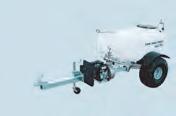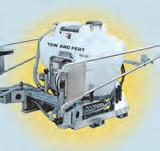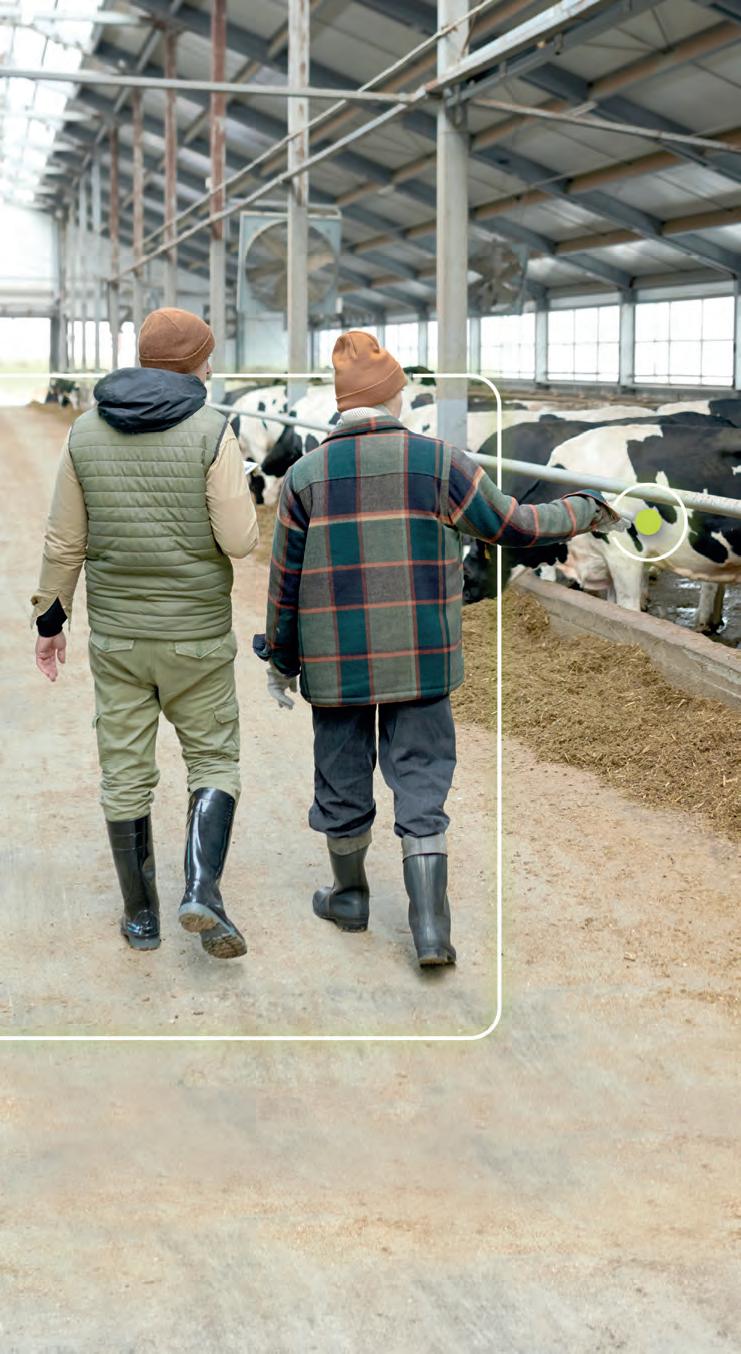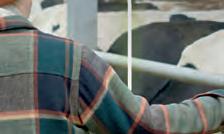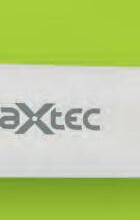Healthier cows are proven to stay in your herd for longer. And thanks to CowScout heat and health collars, you can act faster than ever before if there are potential health problems.













Healthier cows are proven to stay in your herd for longer. And thanks to CowScout heat and health collars, you can act faster than ever before if there are potential health problems.












AFTER AN extended period of reporting similar conditions, above average rainfall, prolonged wet conditions and expectations that this would continue, we are now seeing a clear contrast on the horizon.
The most recent La Niña event has been weakening over late summer and is appearing to be near its end, with both oceanic and atmospheric indicators now moving toward neutral El Niño-Southern Oscillation (ENSO) values.
The ENSO forecast plays an important role in tracking the movement of ENSO through La Niña, neutral and El Niño phases.
Looking ahead, climate models used by the Bureau of Meteorology has indicated that this move toward neutral sea surface temperatures in the tropical Pacific Ocean is likely to remain throughout autumn, before touching on El Niño thresholds coming into the winter.

This outlook is contributing to the heightened likelihood of below median rainfall across most of the country over the next three months.
While this is quite a shift from recent times in many areas, bolstered water resources and soil moisture built up over the same time period will prove supportive moving into the next couple of years.
With many water storages at capacity, and no further resource assessments needed across northern Victoria and the NSW Murray, many will remain confident, at least in the short term.

This confidence has flowed through to temporary water prices, which are currently 72 per cent and 70 per cent below last year across northern Victoria and the Murray Irrigation system respectively.





In light of this, and despite coming into the next season with an outlook of below median rainfall, a jump in both the demand and price of water will be somewhat mitigated by the resources available.


In terms of fodder and feed production, across the cropping areas of southern and central Australia, there are now expectations of a delayed autumn break.
Dependent on soil moisture levels, this has the potential to weigh on predicted planted areas for hay crops and therefore the ability of many to make up for the fodder supply shortfall stemming from last season.
For pasture growth, this outlook will likely bring a mixed response, but definitely a welcomed change for those who battled waterlogged paddocks last year.

Alongside low water prices and cooling temperatures, an equal chance of either above or below median rainfall for parts of south-east Australia, is likely to support pastures over the next few months, dampening demand for purchased feed for the same period.
For a number of grain producing areas, this longer-term outlook and expectations of a delayed autumn break is in addition to a very dry few months over summer.
This has led to drying soils in these areas and is now likely weighing on cropping decisions and prioritisations for the coming season.
For areas that experienced an above average season last year, there are some reports of growers choosing to take a step back this season, in response to this outlook and the high costs they are facing.
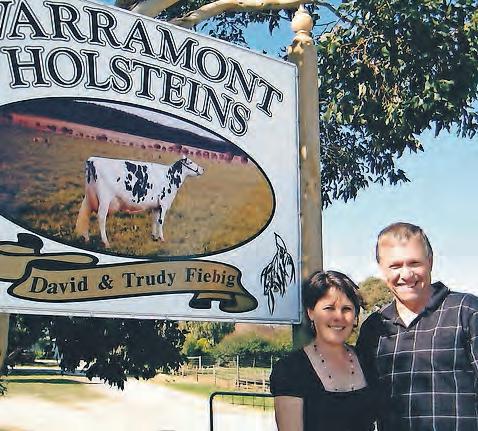
While the material impact of such decisions is fairly unclear due to the bumper harvest in 2022, grain prices are likely to remain high while international interest persists.



forecast






Incessant rainfall, waterlogged paddocks and high fertiliser prices all reduced applications in spring 2022.


As expected rainfall reverts closer to median levels, alongside easing prices, this will be a likely contributor to increased fertiliser use over this coming season.
However, with fertiliser prices again at the whim of global influences, many are likely to continue facing above average fertiliser costs this year.


So, in conclusion, while this outlook is a definite shift from the conditions many have become used to over the last couple of years, the price of both water and feed are likely to remain relatively stable on the back of resources built up over this three-year period.
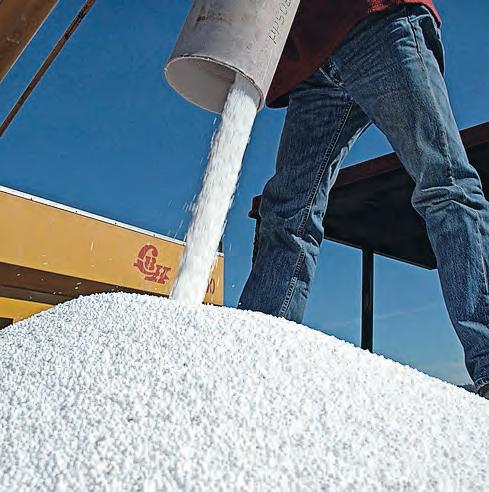
Alongside low water prices and cooling temperatures, an equal chance of either above or below median rainfall for parts of south-east Australia, is likely to support pastures over the next few months, dampening demand for purchased feed for the same period.
THE HERD ’23 dairy production conference drew 200 industry stakeholders to central Victoria on March 15 and 16.
Farmers, scientists and industry experts attended the two-day event in Bendigo to hear updates on current research into sustainable milk production.

DataGene chair and MC for the conference, Graeme Gillan, said the event was well attended.
“There’s [about] 100 businesses represented in the room, either wholesalers, retailers and those in delivery, and there’s over 30 farm enterprises here,” Mr Gillan said.
“It really represents an opportunity for people, whether you’re a dairy farmer or an AI technician, to actually talk to someone who has helped develop the breeding value of dairy cows.
“Over the years since we first started, there has been a number of key initiatives identified that have now come into fruition.”
STgenetics laboratory technician Rachel Meuwly attended the event and said it was a good opportunity to see the impact of her research within a broader scope.
“Our main work is in developing sex-specific semen to give farmers choice in their breeding strategies,” Miss Meuwly said.
“I have really enjoyed the points on sustainability and being a part of the circular economy.
“I hope I can take that back to the lab and help make our work as seamless as possible.
“I think the industry is on track for sustainability but there is always more we can do.“
La Trobe University researcher Professor Jennie Pryce gave the attendees a summary of the role of genetics in creating a sustainable future for the industry.
Prof Pryce said selection based on genomic breeding values was crucial for producing milking cows with greater production and was also good for the environment.
“The ideal cow is one that converts feed into milk efficiently,” Prof Pryce said.
“The focus of this work is on the measuring of methane production.
“However, the reliability of data is relatively low for using GEBVs.
“So we need more data.”
Prof Pryce’s research group relies on measuring methane production of cows by fitting them with costly and work-intensive harnesses that have methane detectors.


Another development for gaining methane data is the use of GreenFeed bins in which



methane is measured while cattle eat with their heads inside an enclosed feeder.
“We only have data from 500 cows, but it is a really rich data source,” she said.
Prof Pryce said sustainability in the industry was “a big deal”.
“Why should we care? Livestock account for six per cent of greenhouse gas emissions.”
La Trobe University PhD student Boris Sepulveda agreed more data was needed as part of his collaboration with scientists in Spain in extracting cow rumen to study the biome (genetic make-up) of digesting microbes.

“The correlation of aspects of the rumen microbe biome with methane production is very strong,” Mr Sepulveda said.
“We have done a pilot study but we need to increase the sample size from other
populations of cows.
“The more cows, the better.
“The breeding for less methane emissions is our main goal and analysis of the genome is just one strategy to achieve it.
“It is also influenced by the cow’s diet.”
The group’s research uses a Sustainability Index determined by the amount of carbon produced per kilogram of protein in milk.
The Sustainability Index was also the topic of GeneTech’s Thuy Nguyen and farmer Tim Jelbart’s presentation.
“What the index does is allow farmers to fast-track breeding for reduced greenhouse gas emissions,” Dr Nguyen said.
Mr Jelbart has produced a cow with Australia’s highest known Sustainability Index.
“She got pregnant at her first insemination, had no mastitis and has a very high Balanced Performance Index,” Mr Jelbart said.
Although the cow was bred as part of the research program and had a very high Sustainability Index, Mr Jelbart was yet to meet her.
“She has sat in a herd of 1000 cows just doing her thing,“ he said.
Dairy farmer Lauren Finger spoke about novel farming methods on her family’s dairy farm in south-east Victoria, which runs 550 cows and breeds Friesians and Jerseys.
Mrs Finger said their farm was unique.
“We are hard to put in a box,” she said.
“We are more aimed toward the business side of farming, rather than the lifestyle side.
“We are pretty much up there on maintaining best practice and people remain a key part of our farm.
“We give our people the autonomy and try to teach them the ‘why’ of what we do.
“We very much hire staff to our values and experience is not a necessity.”
Management of the herd on the farm depended on local conditions and has resulted in very large differences in grain feed to accommodate changes on a seasonal basis.
Mrs Finger said pasture improvement through caring for soil was a key factor in their success.
“We were putting on too much fertiliser, and with over a tonne to the hectare of urea it felt like something needed to change.
“We are now looking more at how nature functions and what we can learn from that.
“We want to work with nature and not against it.”
One method used on the farm is allowing a diverse range of plants to grow within the pasture, including dock weeds.
“Such deep-rooted plants help the soil,” Mrs Finger said.
“We see it as something that’s adding value instead of being a weed; such deep tap-root plants are improving our soil health.
“But an untidy paddock is the result of what’s grown.
“The neighbours don’t like it, but it’s good for the soil.”
David Nation from Dairy Australia and farmer Warren Miles attended Herd ‘23. Mr Miles came from Drummond for the event and said it was a “good opportunity to catch up”. “The more cows, the better,” PhD student Boris Sepulveda says about his research into reducing methane emission per kilogram of protein produced. Mr Sepulveda analyses the genetics of cow rumen to help develop breeding for lower greenhouse gas emissions and says the research needs more data from a larger population of cows.BEGA GROUP executive chairman Barry Irvin has told dairy farmers that the single catchment area of the company’s valley of origin will revolutionise sustainability in farming.
Mr Irvin was the keynote speaker at this year’s Herd ’23 conference in the Victorian regional city of Bendigo on March 15 and 16.
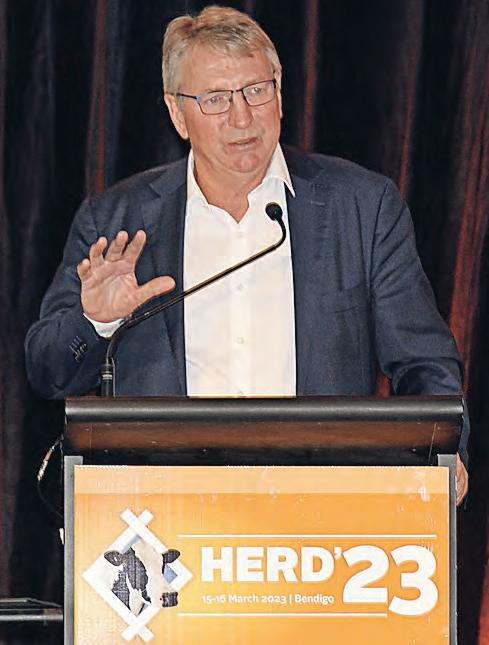
He told the mostly dairy farming audience that the concept of ‘circularity’ had driven the company’s economic and social model to expand and fill the whole Bega Valley Shire on the NSW south coast.
Mr Irvin defined circularity as the process of looking at a business’s supply chain and determining “what’s in and what’s out” in terms of carbon footprint and sustainability.
He said the unique geography of the Bega Valley made it a good model for developing a sustainable future for agriculture.
“We will produce the most circular valley in the world,” Mr Irvin said.









“We need to be the proof of concept.
“There is no point in winning this battle locally if everyone else is still losing theirs.”
Mr Irvin said the Bega Valley had the advantage of being within a single catchment, had only one council and two roads entering and leaving.
“And because the valley is so enclosed, you can measure everything that happens in real time, for example water transport, and allow consumers to see this online.”
He said his philosophy was based on “hastening slowly to get efficiency”.
“My job is not to have the answers but to have the questions.
“Surround yourself with people in the know who have the right knowledge.
Australia’s genetic gain in sires used to produce the next generation of Holstein cows has increased from $6 a year after the first Australian Breeding Values were released, to $30 a year four decades later.
And there’s plenty more for dairy farmers to get excited about, with researchers working hard to develop ABVs for methane emissions, cow health and calf vitality.
That was the message from Bendigo in Victoria, where the Australian herd improvement industry celebrated 40 years of ABVs last month.
DataGene CEO Dr Matthew Shaffer told the gathering of farmers, researchers, and service providers that since 2016 Australian genetic gain has exceeded the international average.

“Twenty years ago, the average genetic gain for Australian Holsteins was four per cent per year, which was half the international average,” Dr Shaffer said.
“Today it’s 28 per cent, well above average worldwide. This is an impressive
achievement and a testament to the hard work and dedication for our entire dairy industry.”

He also acknowledged the contribution made by the Ginfo program during the past 10 years.
“Data has been central to Australia’s
“My task is to listen to that community to manage change.”
The Bega Group was recognised by the Food Systems Summit in New York as a global game-changer.
Mr Irvin said while Australians had much trust in the nation’s farmers, they had less trust in agricultural sustainability.
He said the future of the Bega Valley would have a large impact on changing that perception.
“This is great; we’re not going to go away.
“Bega has joined the global community.”


genetic development and the Ginfo farmers — submitting all their herd information — have been central to making this happen.”
Ginfo is a program which now includes 157 dairy farms and 60,000 cows that submit extensive herd data — including genomic test results — to make up Australia’s reference population.
Data from these animals contribute to the development of ABVs and breeding indexes.
Within the past 10 years — and thanks to the Ginfo data — the Australian dairy industry has had new ABVs for Mastitis Resistance, Heat Tolerance, Gestation Length, Feed Saved, Type composites and an updated Fertility ABV.
The industry also has an index that allows dairy farmers to breed to reduce the emissions intensity on their farms, called the Sustainability Index, as well as the Balanced Performance Index and Health Weighted Index.



Ginfo has also contributed to significant improvements in the reliability of these ABVs and indices, giving farmers more confidence in using them to make breeding and selection decisions.
For example, the reliability of the Daughter Fertility ABV bulls has increased 23 percentage points for Holsteins (and 21 for Jerseys) and 28 percentage points in Holstein cows (and 26 for Jerseys).

Dr Shaffer thanked everyone in the audience for their personal contribution to these outstanding achievements.
“This could only be achieved by genuine collaboration across the entire herd improvement industry,” he said.

“You all played a role and it is exciting to see how much has been achieved.”
The celebratory dinner was held in conjunction with the Herd ’23 conference — a collaboration between DataGene, Dairy Australia, Holstein Australia and National Herd Improvement Association of Australia.
Bega Group executive chairman Barry Irvin told the Herd ‘23 conference that while Australians have much trust in the nation’s farmers, they have less trust in agricultural sustainability. He said the future of the Bega Valley would have a large impact on changing that perception. Photo: Simone Smith DataGene CEO Dr Matthew Shaffer says the Australian dairy industry has gone from lagging markedly behind international average rates of genetic gains to now exceeding the international average.ULKE DE Kleine moved to Australia for the opportunities and to south-west Victoria for the rain.
The large barn at his Pirron Yallock farm was a big bonus and he likes it so much, he might build another one.
Dutch-born Ulke likes high-intensity and high-production farming and the barn has been a major tool in achieving his goals.
Ulke had tried a few different options before settling on Australia.
“I didn’t come from a farming background but I wanted to get into farming so I explored the world,” he said.
He worked for more than a year in New Zealand, Canada, the United States and Ireland to experience their farming systems and look at possibilities.
The last resort — Australia — turned out to be the best option.
“I moved here in 2011 because of the opportunities offered by Australia,” Ulke said.
“It was affordable then, and I still think it is now as well.
“I always wanted to be a dairy farmer. I liked the idea of the freedom of farming, being in the open environment and out in the elements and I had a love of cows.”
Ulke settled in northern Victoria and in 2012 moved to another farm.
In 2013 he met his wife Sarah, and in 2015 they took over half of her family’s farm at Katunga, about 45 minutes north of Shepparton, from her parents Ray and Lorna Trimby.

They had no plans to leave the region, but fate intervened.
“We weren’t for sale but someone knocked on the door and asked if we wanted to sell the farm,” Ulke said.
“They were after the water. There is an issue with less allocations and high water prices.
“We considered the opportunity and thought if we were going to move, we were going to go to an area with more rainfall.”
They decided to go south for the rainfall and moved to Pirron Yallock on July 1, 2021.
Ulke recently shared his story during a WestVic Dairy workshop to give farmers options to improve their feedbase and nutrition strategies.
They started with 405ha and 750 cows, and in the past six months have expanded to 688ha, including 73ha in a long-term lease.


The plan this winter is to milk 1100 cows.
While more regular rainfall was the driving factor in the move, the 20-year-old barn was a definite attraction.
“We had a feedpad in northern Victoria but not a barn,” Ulke said.
“I always had a vision to build a barn or something similar for housing cows so that was one of the main reasons we went for this farm.
“I like more intense farming; I’d always had an ambition to push production.”
The barn is 172-metre long and can house 500 cows. It has open sides for ventilation.
Because of his experience in Northern Hemisphere farming systems, Ulke was familiar with barn operations.
The Holstein herd is divided into inside and outside herds, with the high-producing cows in the barn and the low producers outside.
Since moving into the barn, the cows’ production has continued to increase.
They are fed home-grown silage, lucerne hay bought in from northern Victoria or southern NSW, and concentrate — all fed through the mixer wagon.
About eight months ago, Ulke introduced a robotic feed pusher.
“It has made life easier for us,” he said.
“You don’t have to think about it. It does it eight times a day at a set time so the cows always have access to good feed.”
Ulke is confident the cows enjoy the barn system.

“The biggest thing I found is that our cows became a lot calmer in the shed.
“They like it — there’s always feed in front of them and it’s not like in the paddocks when you give them feed and they all push up against the fence trying to get it.”
The shed is flood-washed twice a day using a system that was already installed.
The daily routine starts with the cows being let out of the barn at 3.30am, with milking starting at 4am and the first cow is back in the shed by 4.15am.
They repeat the same process again in the afternoon, starting at 2.30pm.
It takes about 90 minutes twice a day so the cows get about three hours out of the shed. The grazing cows are milked after the shed cows.
Advertising Max Hyde 0408 558 938 max.hyde@dairynewsaustralia.com.au
Editor Fiona Lloyd (03) 5820 3254 editor@dairynewsaustralia.com.au
Regional editor news@dairynewsaustralia.com.au
With his desire to push production, Ulke will look at further expansion options.
“We’re going to be 50:50 grazing and barn because of the capacity of the shed, but longterm we have ambitions to build another shed.
“I’m not going to stop grazing but I reckon another barn would be good in the hot months so the cows can be in the shed out of the sun during the day and at night they can go out and graze.
“When it’s very wet, the same thing. You can house them for a few days instead of pugging the paddocks.”
He is also considering a shift to three times a day milking.
“I reckon in a couple of months if we keep getting more production, we might have to do it.”
Publisher Shepparton Newspapers Pty Ltd
Printed by Newsprinters Pty Ltd
Head Office 7940 Goulburn Valley Highway Shepparton, VIC 3630
Phone (03) 5831 2312
Postal address PO Box 204 Shepparton, Victoria 3632 Australia
Ulke aims for 10,000 litres or 750kg MS and is close to hitting the mark.
Another potential change is the calving pattern. They currently calve 10 months of the year, starting February 1, only missing December and January.
“I’m not sure what we do next year — we might go to 12 months a year,” Ulke said.
“I want to keep the milk flow going. My bills are the same every month so I want to keep the income coming in.”
Along with Sarah, who Ulke describes as the backbone of the business, the farm has six permanent staff members and four backpackers.
“We’re happy with the move to the southwest; we don’t regret it one bit,” he said.
Dairy News Australia welcomes contributions from stakeholders in the dairy industry, and particularly from organisations wishing to advance the industry.
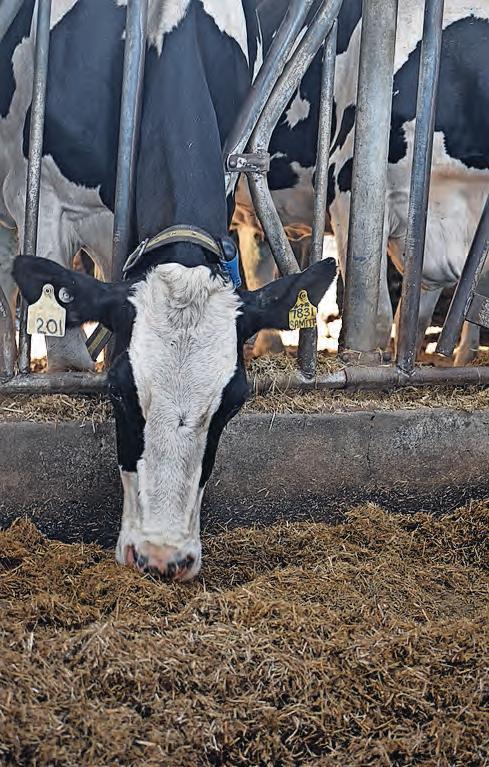
Contributions and photos can be sent to: editor@dairynewsaustralia.com.au
Letters to the editor on topical issues are also welcome.
Letters should be concise and carry the name and town address of the author, as well as a contact phone number, not for publication.
Ulke and Sarah De Kleine with one of their children Marli, 4, and Sarah’s mother Lorna Trimby. Ulke De Kleine moved to south-west Victoria for more consistent rainfall, but the barn was also a big attraction. Ulke is considering a shift to three times a day milking. The barn is working so well that Ulke is considering building another.
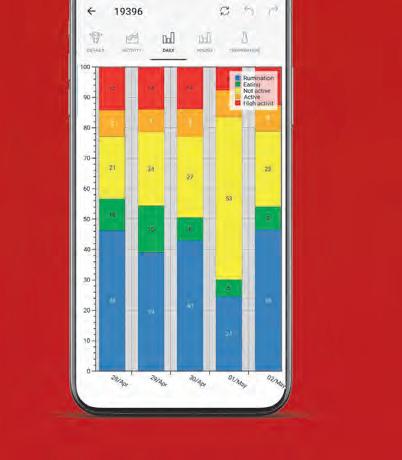






















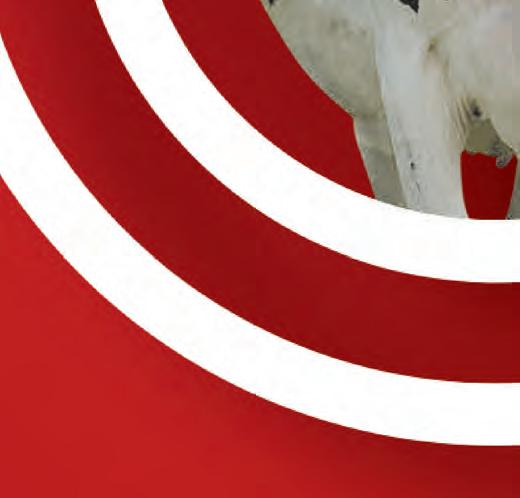
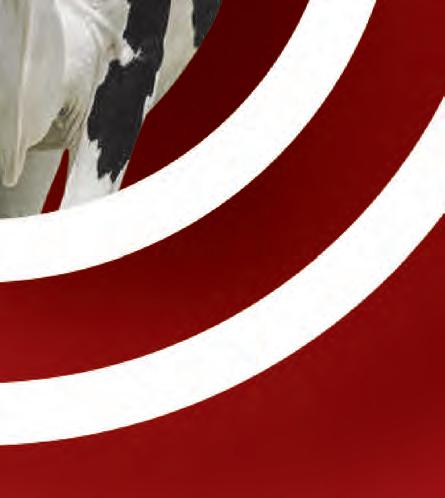



DAVID AND Trudy Fiebig of Warramont Holsteins were back in the dairy milking the last 25 cows after the third of their staged dispersals on March 8.
In the past two years, the Mt Gambier dairy farmers have sold almost their entire herd.
“These last cows are old and they’ll go in about six weeks,” David told Dairy News Australia
The couple will then invest in breeding beef, with Angus and Speckle Park genetics.
After 40 years in dairy, they are retiring from the industry. Like many, their decision was impacted by workforce, or the lack of available farm workers.
“I was reliant on backpackers and that dried up,” David said.
David and Trudy began in the dairy industry 40 years ago, sharefarming for his parents. Then they bought 40ha and their career as dairy farmers began.
“Our herd and farm slowly grew over 27 years,” David said.
The Master Breeders established Warramont Holsteins at Mt Gambier in South Australia and their genetics have spread throughout southern states.

The top selling cow at the first stage dispersal, held on March 15, 2021, Warramont Diamondback Fondue, was bred from the former Melbourne and Adelaide Royal Champion Warramont Winluke Frosti. The young



second-calving cow was bought for $24,000 by Simon Wilkie of Bacchus Marsh.
At the same sale, Warramont Doorman Daybreak 10, bred down from Elite Mountain Dreamer, was bought for $13,500 by Peter Fullerton, Nirranda South. He also bought maternal sisters, Warramont Heath Dallas at $6750 and Warramont Xmas Dallas for $6000.
There were 50 females on offer from the maternal line established by Elite Mountain Dreamer.
Forty autumn calving heifers sold to a top of $5750, for Warramont Solomon Lady, bred from the Glomar Lucky family.
The first dispersal sale averaged $3910, for 92 cows and 38 in-calf heifers, with buyers from Victor Harbour, Mt Gambier, Gippsland, and south-west and northern Victoria.
There was strong demand for the 66 tested A2 cows and heifers, which the Warramont Holstein herd is renowned for.
The second dispersal sale, also held at Mortlake Western Victoria Livestock Exchange, on August 13, 2021, saw a top of $4750 paid and an average of $3100 for 105 Holsteins. Unfortunately, the pandemic lockdown meant the vendors couldn’t cross the Victorian border to attend the sale.
Warramont Kingboy Daybreak 13, a six-yearold cow, was purchased by Peter Fullerton at the top price of $4750. He also purchased a heifer, Warramont Fedora Deluxe, for $4200.
The second-top price of $4700 was paid for another heifer, Warramont Pharo Faye.
Jancourt East buyer N. Niewenhuizen
selected several lots, including Warramont Malonred Emblem, a young red cow that sold at $4600; Warramont Pharo Jessica for $4600, a heifer from a dam milking 10,000 litres; and Warramont Rager Flirt, a red heifer bred down from the Royal Champion Warramont Winluke Frosti, sold at $4300.
Warramont Meridian Frappe sold for $4500 to Leslie Manor Farm. Warramont Solomon Major, a heifer backed by eight generations of VG dams, sold for $4200.
Warramont Bardo Fleece sold for $4000.
The second sale saw Holstein cows and heifers dispersed throughout the dairy regions of Victoria.
The third and final dispersal sale, also at Mortlake WVLX, was held on March 8, 2023, and was notable again for the interest from buyers from across South Australia and Victoria.
There were mostly heifers for sale, many carrying sexed dairy heifers in-utero.
The tested A2 classified heifers were particularly in demand. The remaining 54 cattle sold for an average of $4025.

The top price of $7200 was bid for the A2 classified heifer Warramont Sidekick Lily, an ET twin sister to the champion cow, Warrabel Blade Lucky, bred from the Glomar Lucky line.
The bidding was swift for this heifer, in calf to an Angus bull, jumping in $500 increments to $6500, then by $250 to $700, before rising in $100 bids.
The heifer Warramont Rubels Flame-Red, also in-calf to an Angus bull, was also popular, selling for $6500. Bids jumped in $500 increments to
$4500, then by $250 bids to $6500.
There were several Radio daughters that sold well. Warramont Radio Frequency, tested A2 and in-calf with a heifer to Carenda Varley, sold at $5000. Warramont Radio Flash, also tested A2 and in-calf to an Angus bull, sold for $5800.
Warramont Radio Jacinta, just on two years old and in-calf with a heifer to Delta-Lambda, attracted six bidders — three on the floor of the livestock exchange and three online — finally selling for $6250.
The Christmas line was also popular. Warramont Cold Delight, a heifer tested A2 and in-calf with a heifer to Winterfell, sold at $5500.
Warramont Cold Desire and Warramont Cold Sleet, both naturally polled and in-calf with dairy heifers, sold for $4500 and $3750 respectively. Sleet was also classified A2. Warramont Cold Donna, tested A2 and in-calf with a heifer to Kings Ransom G Dylan, sold for $5300. Bidding by $250 increments rapidly rose to $5000, then $100 bids closed the deal.
Warramont Megasire Daisy, born in 2015 and calved in January this year, milking 844kg milk solids, with a cell count of 15, sold for $3250.
Prices held up well across the sale, with various A2 tested and in-calf heifers selling for $5000, $6000, $5300
Warramont Luster Milky, lot 37, a heifer in-calf to an Angus bull, is from a line of cows that milked 100,000 litres. She sold for $6750 after a three-way bidding contest on the floor of the livestock exchange.
Selling agents were Dairy Livestock Services and Elite Livestock Auctions.
• A Packo milk tank and system to suit all herd sizes, pick up schedules,and entry temperatures • Simple one button operation to activate either cooling or wash modes • Packo's Patented fully automatic Rotojet cleaning system, ensures every square in of the inside vessel is clean and hygienic.

 After 40 years in the dairy industry, Trudy and David Fiebig of Warramont Holsteins, Mt Gambier, have sold their milking herd and heifers in three dispersal sales and will ‘semi-retire’ to be beef breeders. Workforce shortage was a key factor in their decision to exit the dairy industry.
After 40 years in the dairy industry, Trudy and David Fiebig of Warramont Holsteins, Mt Gambier, have sold their milking herd and heifers in three dispersal sales and will ‘semi-retire’ to be beef breeders. Workforce shortage was a key factor in their decision to exit the dairy industry.


















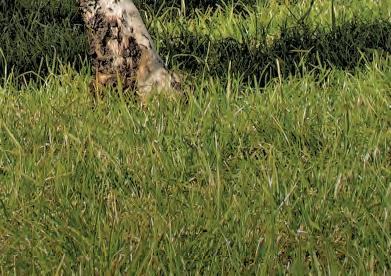

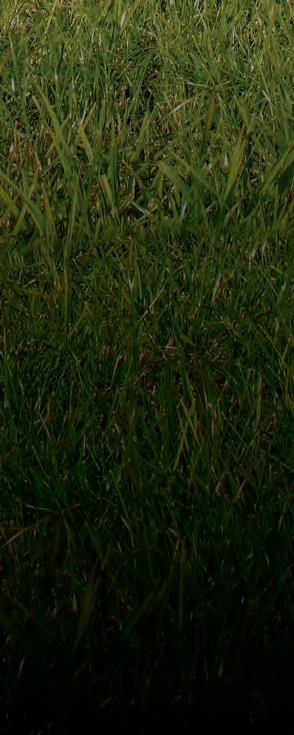
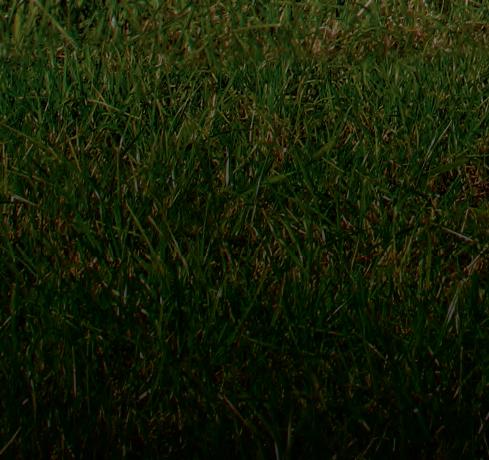





























WILANDRA FARMS has invested in energy-saving developments, renewable energy, irrigation efficiency and automation, and an energy management system, to significantly reduce their energy bills and carbon footprint.

Sandra Jefford and Wilco Droppert are dairy farmers who trade as Wilandra Farms, at Clydebank in East Gippsland, Victoria.


They hosted a very well-attended field day on their property in February to tell their story about the effect of the changes they have so far implemented.



See the full story on page 22.
 Tom McMillan and Steph Lahm, dairy farmers at Bundalaguah, and Lavinea McMillan, also of Bundalaguah.
Luke Droppert and Tiah Capobianco from Wilandra Farms, Clydebank.
Norm Drew of Cowwarr, Kaylee Bransgrove of Neerim and Nicole Wells of King Valley Dairy.
Lilia Coleman, Rosalie Coleman, Matthew Coleman, all of Riverslea, and Mark Coleman, Wellington Shire Council.
Photos: Jeanette Severs
Tom McMillan and Steph Lahm, dairy farmers at Bundalaguah, and Lavinea McMillan, also of Bundalaguah.
Luke Droppert and Tiah Capobianco from Wilandra Farms, Clydebank.
Norm Drew of Cowwarr, Kaylee Bransgrove of Neerim and Nicole Wells of King Valley Dairy.
Lilia Coleman, Rosalie Coleman, Matthew Coleman, all of Riverslea, and Mark Coleman, Wellington Shire Council.
Photos: Jeanette Severs
IN A world first, the Australian dairy industry has released a comprehensive national set of guidelines to help farmers looking to invest in innovative feeding and housing solutions avoid costly mistakes.

The release by Agriculture Victoria and Dairy Australia of the 245-page National Guidelines for Dairy Feedpads and Contained Housing provides an invaluable resource to farmers across all
services Scott McDonald has worked closely with many farmers over this transition phase and believes the shift has been in order to address a range of farming and regional specific challenges including climate adaptation, water availability, workforce efficiencies, improvement in environmental management, and enhanced animal health and production outcomes.
“These guidelines, which are the first of their kind anywhere in the world, draw on the insights of international, Australian and Agriculture Victoria’s experts to provide Australian dairy farmers with a global best practice approach while also considering our local Australian conditions and regulations,” he said.
“They will be an invaluable resource for all Australian dairy farmers.”

Dairy Australia feeding and farm systems lead Karen Romano said it was vital that any farm looking to move to intensive farming systems carefully considered what was the right system for their farm in both the short and long term to avoid costly mistakes.

“Changing land use to intensive farming is a significant investment and therefore requires more complex decision making, planning and a longer term vision for the farm,” she said.
“To assist farmers in carefully assessing the right intensive system for their farm, Dairy Australia has worked closely with Agriculture Victoria to support the production of the first-ever National Guidelines for Dairy Feedpads and Contained Housing as a decision-making resource.”
The release of the guidelines is part of Dairy Australia’s ongoing efforts to enhance farm business management by providing dairy farmers with access to business planning and risk management tools and insights to support on-farm decision making and improve profitability.
Dairy Australia, Agriculture Victoria and the NSW Government are also investing in the development of a decision-making tool called the Farm System Evaluator which will allow farmers to assess their preparedness for transitioning to an intensive system.
A national multi-year study of farms that have already moved to contained housing systems (zero-grazing system) is also being undertaken by Dairy Australia to help farmers understand potential impacts on their short and long-term financial performance.
Download the guidelines from the Dairy Australia website.
What if you could proactively improve calf and cow health sothey can better withstandchallenges, including those caused by mycotoxins?
What if you could control calf diarrhea before an outbreak, and reduce the incidence, severity and duration of other common diseases that affectthe feedconversion efficiency of lactating cows and your bottom line?

What if you could add nutritional insurance to every stage of your cattle’s lives resulting in healthier heifer calves that join the milkingherd ready to contribute at a high level, and lactating cows that spend less time off feed.

Has been shown to:
•Agglutinates and binds E. coli and Salmonella enterica.
• Agglutinate and bind E. coli and Salmonella enterica.
•Reduces the incidence, severity and duration of mastitis and cryptosporidiosis infection.
• Reduce the incidence, severity and duration of mastitis and cryptosporidiosis infection

•Reduces blood stress markers during and after transport and temperature stress.
• Reduce blood stress markers during and after transport and temperature stress
• Minimise cytotoxic damage caused by a variety of mycotoxins and carryover of aflatoxins in milk
•Minimises cytotoxic damage caused by a variety of mycotoxins and carryover of aflatoxins in milk.
• Improve weight gains and performance in calves and milk yields in lactating cows
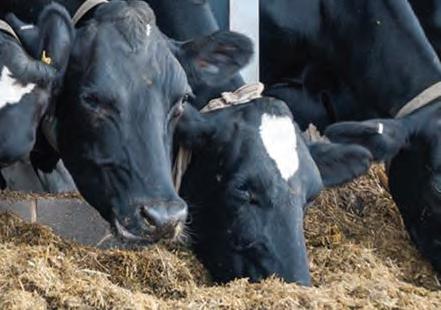

•Improves weight gains and performance in calves and milk yields in lactating cows.
Distributed By:
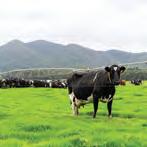
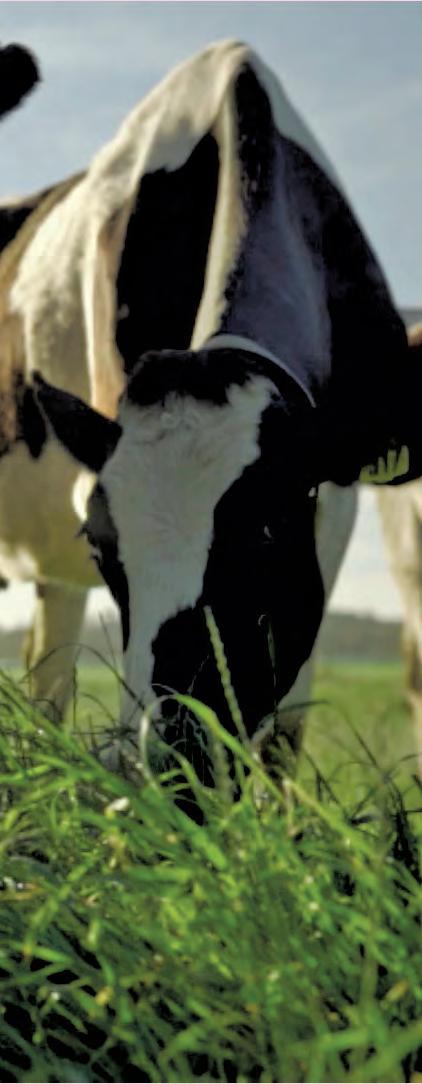

With insights into each cow, our DairyRobot R9500 not only automates the complete milking process. It gives you real-time data that’s easy to read and provides valuable feedback from every milking.
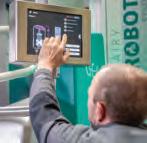

What’s your next step?
GEA.com/australia

 Intervene at the earliest sign of a problem
Suited to pastoral milking systems
Full milk analysis & automatic milk vat diversion
Every step of the milking process handled in a single attachment
Intervene at the earliest sign of a problem
Suited to pastoral milking systems
Full milk analysis & automatic milk vat diversion
Every step of the milking process handled in a single attachment
LIAM ALLAN started sharefarming in 2018 under Paul and Christine Moloney, in Terang in south-west Victoria.


They milk about 270 cows and started using a cow monitoring system in 2015 and CowManager’s Fertility Module is something they rely on daily.
Liam is enthusiastic about using the CowManager system.
“It’s been fantastic,” he said.
“We have that data there so we can have an early go at AI-ing, put a program in place for cows that are not cycling.


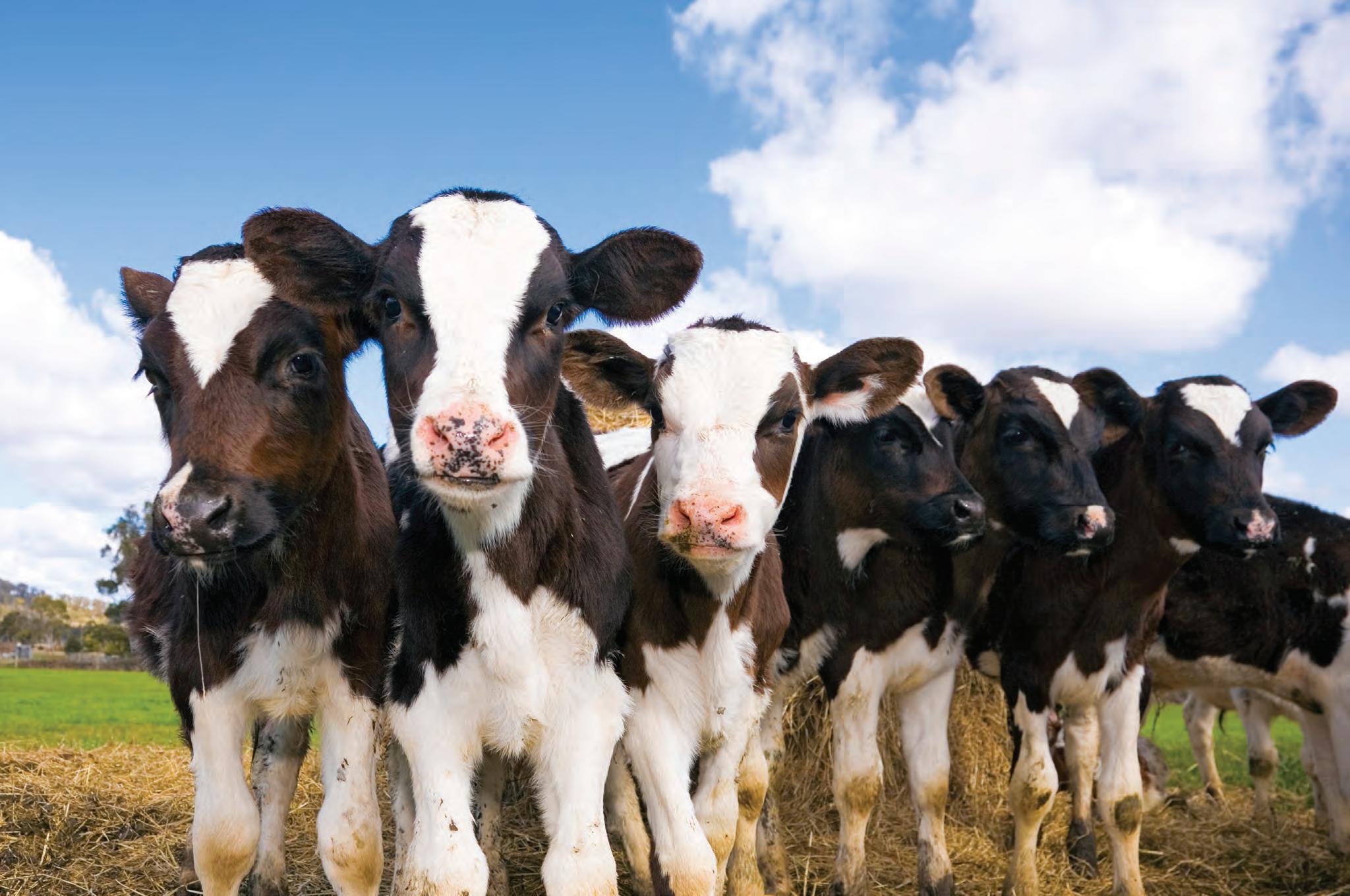

“And just the ease in general, to not have to worry about stickers or tail paint and all that stuff.”
Sharing data is key
They use CowManager’s Fertility Module as their main heat detection tool.
It also has a Fertility Insights feature that allows for a data deep dive into cows’ cycles.
The herd’s health is monitored around the clock with CowManager’s Health Module, which catches diseases one or two days before a cow shows clinical signs of being ill.

“It’s just made it heaps easier,” Liam said. CowManager’s MultiView functionality also makes shared farming that much easier.
Anyone can access the selected cow data anytime, anywhere.

A person’s email addresses just needs to be added to the system and they can then view all cow history and cow data, all the way back to the install date.
This means the entire team is always up-tospeed, including vets, nutritionists, and AI-specialists.
“At the time we’re using sexed semen on all the heifers coming in and we started using sexed semen on the cows this year,” Liam said.
“We’re going off the data from the tags to see which cows have been cycling the most, which are the highest in fertility.
“It’s worked really well; we’ve had some really good conception rates.”

Liam’s happy to be able to take some time off every now and again because he knows the herd will be monitored by the system, even if he isn’t there himself to check on the cows.
“I enjoy playing footy and that sort of stuff. And if I ever have a function or something like
that, the next day I can have a sleep-in.”
It’s made the day-to-day workload a bit lighter as well, he said.
“We can trust the system and know the cows are going to get caught, and everything’s right for the next day.
“All that the milker has to do, is to remember to shut the gates out the side. Everything else sorts itself out.
“I’ve been grateful for that a few times.”
Making life easier
Liam’s pretty matter of fact about the benefits of using the CowManager cow monitoring system and doesn’t hesitate when asked if he’d recommend it to neighbours or colleagues.
“I’d definitely recommend CowManager to other farmers.
“It’s a great asset to have on your farm. It makes life a lot easier.”
CowManager’s Multiview means anyone can share the cows’ data anywhere, anytime.
A JOINT trade mission has uncovered a growing thirst in Pakistan for Australian dairy genetics, heifers and milk.
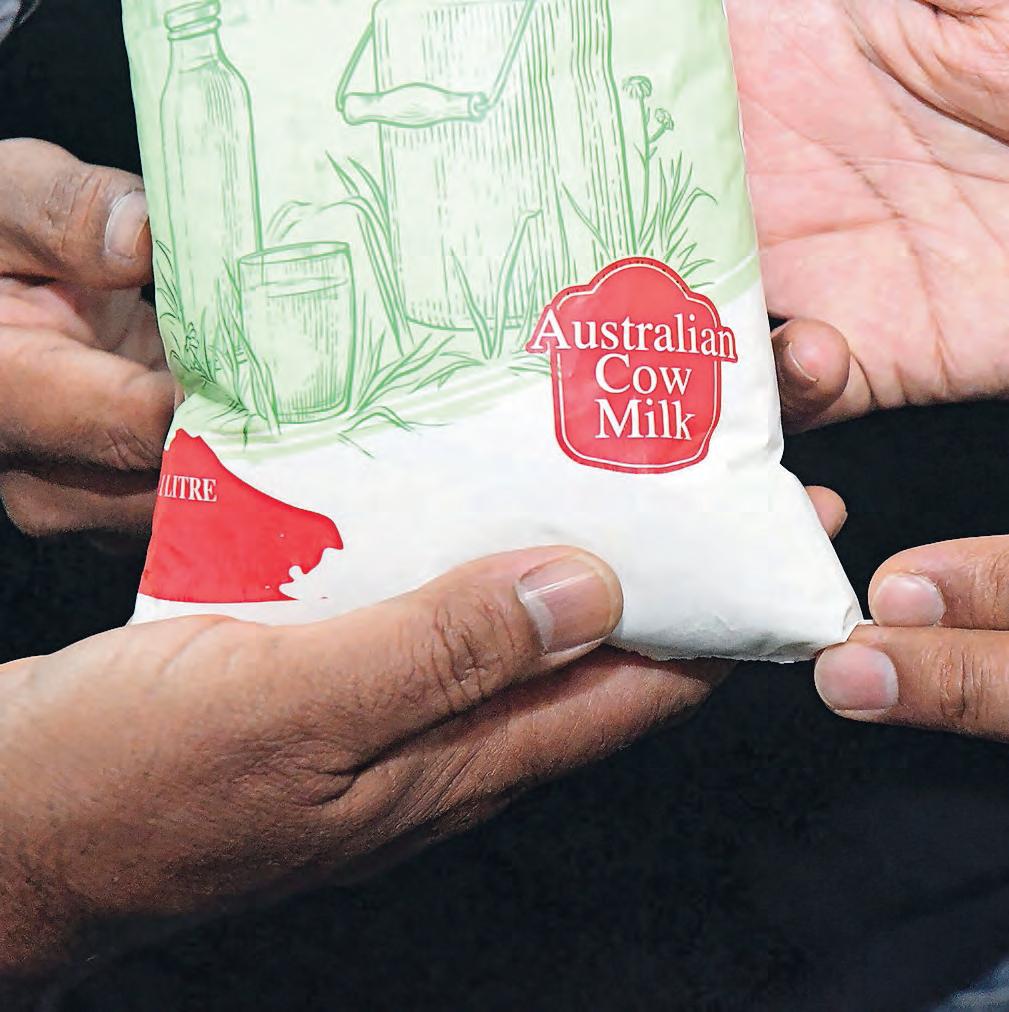
The delegation of Jersey Australia general manager Glen Barrett, Genetics Australia’s chief executive officer Anthony Shelly and export manager Rob Derksen, and Holstein Australia chief executive officer Rohan Butler is set to open more export opportunities for Australian farmers.
They found a Pakistani dairy industry keen to grow with a focus on high-quality cattle.
Genetics Australia entered a partnership with HRM Dairies in late 2020 and the corporate farm has become the first in Pakistan to use Australian genetics and genomic testing.
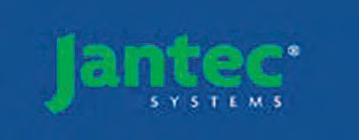
About 1400 heifers with a focus on high BPIs were exported from Australia in December and a further shipment is planned later this year. A Pakistani delegation is expected to visit Australia in April to discuss further opportunities.
The February delegation aimed to promote and support Australian genetics and expand market opportunities and included visits to HRM Dairies and their import partners Riverline Dairies, the National Dairy Expo at Lahore, corporate farm events and several private farms.

Mr Barrett said there was a lot of interest about all aspects of Australian dairy.
“The thirst for information was very high, whether they were milking one cow or 1000 cows,” he said.
“Everyone wants to know about Australian cows and genetics and how Jersey or Holstein cows can work for them.
“Dairy is seen as a good investment opportunity and Australian genetics are in high demand.

“The fact that they have Aussie cow milk on their packaging shows their high regard for Australia and Australian cattle.”
Mr Barrett said Pakistan was particularly interested in high-quality pedigree animals.
“That’s why Australian genetics have great appeal,” he said.
“The animals from the recent shipment have travelled well, settled in well, maintained weight and look very content. They look a cut above the local cows.”
Mr Shelly said Pakistan was starting to change focus from small-town production to larger, more sophisticated commercial milk production and supply.
“We could see that in the investment and development that is happening on farms,” he said.
“There are many farms being set up to milk more than 1000 animals which is exciting because it demonstrates there are longer-term opportunities for Australia.”
Mr Shelly said feedback from farming operations that had received Australian cattle late last year was very positive.
“That’s a strong start for the Australian industry to leverage off for future opportunities,” he said.
Mr Butler said the trade opportunities would benefit both Australia and Pakistan.
“It’s great for our Australian farmers because they have an opportunity to make good-quality excess heifers for export, and Pakistan is purchasing good-quality breeding animals that will help their industry,” he said.
“There has been a huge change in the quality of animals leaving the country since sexed semen took off, and that’s a win for everybody.”
Mr Butler said Australian dairy’s “clean and green” reputation put it in a good position to be part of Pakistan’s growing market.
“We’ve got a strong market in China for live cattle but we want to diversify and this is a great opportunity for all parties,” he said.
Despite the positive visit, there are some challenges facing future trade.
“Political unrest and economic uncertainty may dampen opportunities this year but we are hopeful that we can expand the market,” Mr Barrett said.

 Rob Derksen, Glen Barrett, Rohan Butler and Anthony Shelly recently returned from Pakistan where they promoted Australian dairy and genetics.
Rob Derksen, Glen Barrett, Rohan Butler and Anthony Shelly recently returned from Pakistan where they promoted Australian dairy and genetics.



QUEENSLAND SCOOPED the pool at the 2023 Australian Grand Dairy Awards held in Melbourne in March.




The awards, which recognise and reward excellence and quality in Australian dairy produce and are considered the industry’s most prestigious and highly regarded accolade, saw Queensland producers take out six of the 18 awards up for grabs.
Victoria followed with four titles, Tasmania three, NSW scored two, Western Australia two and South Australia one.

The two most prestigious awards, the Grand Champion Dairy and Grand Champion Cheese, saw two Queensland producers recognised:
Woombye Cheese Company on the Sunshine Coast was awarded Grand Champion Cheese for its Woombye Blackall Gold Washed Rind.

Sunnybank producer Milani Minus Eight Degrees took home the title of Grand Champion Dairy for its Crème Brulée Gelato.
Entries spanned 320 products from various manufacturers across 18 classes including milk, yoghurt, ice-cream, butter, cream and an array of cheese.
Respected dairy educator and chief judge Russell Smith said the awards were about spotlighting local manufacturers
and provided an opportunity to celebrate innovation within the Australian dairy industry.
“Australia has some incredible dairy producers, and we know Australians care about the provenance of their food more than ever,” Russell said.

“These awards put the best of the best in the spotlight. Congratulations to all producers who have entered this year.”

Woombye Cheese Company producer Beth O’Leary said the Grand Champion award was welcome recognition of the years of work that have gone into producing the perfect cheese.
“We have an amazing team behind us, and we are thrilled to be taking this achievement home to those who have been a part of its success,” she said.
Milani Minus Eight Degrees founder Yue Lin said bringing a little bit of indulgence to its customers every day was a privilege.

“Our Crème Brulée Gelato is one of our most popular flavours — we know it’s a winner every time. But to be recognised nationally and receive this prestigious award is an honour.”
For more information, visit:https://www. dairy.com.au /our-programs/australiangrand-dairy-awards/2023-australian-granddairy-awards
THINK OF Israel and initial thoughts would likely relate to an area of considerable historical significance where events that have shaped the world have their origins.
From Jerusalem and the Wailing Wall to the Dead Sea and the Sea of Galilee, the country is defined by sites of religious and cultural


Within these settings there is also a prosperous agricultural system, despite the often harsh climatic and geographical challenges typical of the Middle East, challenges that have been overcome and which have enabled development of efficient food production systems.
The dairy industry is reasonably small with around 120,000 dairy cows, but has developed to be one of the most productive in the
REDUCED MILK FEVER IMPROVED FERTILITY
FULLY SERVICED
world with average lactation yields more than 12,000 kg/cow.
Hot temperatures and lack of suitable land areas put pressure on the production of forages, meaning the key forage grown is wheat silage — most prevalent as this crop can make better use of the winter rain during the growing season.
Lesser areas of maize silage, alfalfa (lucerne) and wheat hay are also produced.
These production challenges and low availability of forage led to somewhat unusual low-fibre diets, with forage typically around 35 per cent of the ration mix supplemented with cereals and other by-products.
Other common ingredients used in rations include maize grain, maize gluten, rapeseed meal, cottonseed and distillers grains.
The Israeli cow is a hardier breed than the standard Holstein-Friesian, a result of local breeding which has produced a smaller animal able to cope with the warm summers and low-fibre diets available.


Despite the low forage content of the diets, milk solids remain impressive — with milk fat typically around 3.9 per cent and milk protein 3.4 per cent at this time of year (Australian summer).
Farmers and nutritionists face additional challenges where religious practices affect what feed can be offered where kosher practices are in place. For example, wheat must be removed from the diet during the Passover period and diets reformulated — quite a challenge where wheat-based ingredients may be
a key part of the forage and supplement parts of the diet.
Diets may run around 25 per cent starch and rumen-protected fat supplements are used in practically all diets, primarily as energy sources, and to improve milk fat production for which farmers are paid.
Calcium salt fat supplements have been used historically but the use of milk fat-boosting ‘high-C16’ supplements has increased recently with a push for higher milk fat by processors, particularly during heat stress periods when milk fat declines.
Most dairy herds are located in the traditional Kibbutz communities — co-op arrangements where people live together and share the workload and outputs from the farms and other businesses, as well as in the Moshav system where businesses are more individually owned.

Animal feed is primarily produced by

Prelac, by Performance Feeds is a palatable molasses based supplement that provides essential vitamins and trace minerals. Conveniently customised to meet your herds’ nutritional needs, Prelac is fully serviced and specially formulated to boost performance in springing cattle during the transitional phase. Ensure that your dairy cattle have sufficient nutrition to maintain condition and grow a prenatal calf by using Prelac.
Reduced Milk Fever
Reduced Calving Difficulties

Improved Fertility
Fully serviced program

Equal access to supplementation
Reduced retained foetal Membranes
Dr Richard Kirkland.






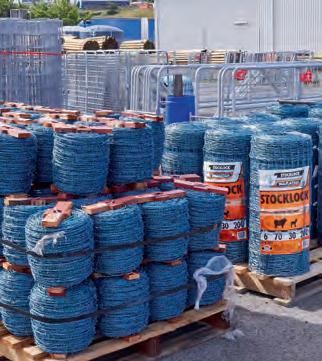

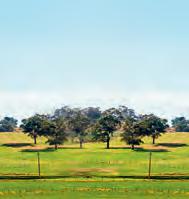





AS A keen observer of Mother Nature, it seemed to me that signs of autumn began appearing a few weeks early this year — with deciduous trees in many of our smaller rural communities turning to yellows and reds mid-February.

Some reasonable rainfall has seen much of the Western District green in March following a mild summer, and for me at least, the arrival of autumn is always a relief from the anxiety of the fire season.
It's been a busy start to the year, with events returning to their pre-pandemic calendar slots — the Australian Dairy Conference in Hobart hosted more than 600 delegates and WestVic Dairy was pleased to support three young farmers to attend.
Congratulations to the organising committee of the Cream of the Crop event, held this
year at Koroit, for another successful gathering of women in dairy.
The WestVic team is busy organising our feature event for 2023, Dairy NiteMoooves, to be held at Noorat on Wednesday, May 24 — so, save the date.
This fun-filled evening will be an opportunity for people in the dairy industry to enjoy a great night out with fabulous food, entertainment and music.
Just before Christmas, WestVic welcomed Sheeraz Ahmad to the team, working as our new regional extension officer in farm business management.
Sheeraz comes to us after many years working at the University of New England in Armidale, NSW, where he completed his PhD in Agribusiness Management.
Chris Walsh continues to roll out the Our Farm Our Plan project and is always looking to expand the reach of this important initiative.
If you think this might be something of value for you and your farm team, give the office a call on 5557 1000.
The new Dairy Farms Job Board is being used extensively to advertise positions on farms right across the country. You’ll find it on the Dairy Australia – Dairy Matters website. If you need any help navigating the process, call the WestVic office and ask to speak to the workforce attraction lead.
The autumn calving period will be well under way by the time you have your copy of Dairy News Australia.
Here’s hoping it all goes smoothly — the grass has grown, calf facilities are all prepared in time, and your farm team fit and ready for another season.
Remember that your Dairy Australia team in the Western District is always there for advice, support and assistance.
Jacqui Suares WestVic Dairy chair
There are signs of autumn all around.
Despite higher retail prices and financial pressures facing consumers, dairy remains a staple product, according to Dairy Australia’s March 2023 Situation and Outlook report.

The majority of Australian households continue to purchase dairy (97 per cent) and more households (33.8 per cent) are shopping between four or more retailers, as they look for cheaper options.

Opting for private label products continues as a key cost saving strategy.
While the volume of milk sold has dropped slightly by 1.5 per cent, the volume of private label products sold rose 1.1 per cent in the 52 weeks to January 29, further increasing the portion sold compared to branded milk.
Volumes of cheese and butter are also falling, but yoghurt continues to buck the trend, growing 1.7 per cent.
Dairy Australia forecasts a contraction of between four to six per cent in the Australian milk pool this season, due to worker shortages, competition for land and resources, and wet
weather conditions.


With milk production contracting, Australian dairy’s commodity prices are strong compared with other exporting countries, helping insulate the industry from some of the pressures emerging overseas, the report said.
Global commodity values have dropped, along with international demand for dairy.
“The level of dairy product available for export globally is growing, as production in other countries outweighs local demand,” Dairy Australia industry analyst Eliza Redfern said.
“Global commodity prices have reduced, with wholesale buyers more price sensitive as challenging economic conditions continue and many countries on the brink of recession.
“Australian dairy exports are extracting a larger-than-usual premium on the global stage, held firm by limited product availability.”
For more information and to view the latest Situation and Outlook report, visit: dairyaustralia.com.au/sando
Despite higher retail prices and financial pressures facing consumers, dairy remains a staple product.VATBUSTER range of mixes are proven versatile seed blends of long rotation diploid/tetraploid enhanced late seeding perennial ryegrass, with or without legumes, for high performing dairy and beef animal pastures. VATBUSTER has strong year round production, high ME and palatability thanks to these leading varieties:
• Base AR37 Perennial Ryegrass
• Matrix SE Perennial Ryegrass
• Reward Endo5 Perennial Ryegrass
• Legacy, Quartz & Mantra White Clover
• Reaper & Amigain Red Clover
With VATBUSTER our main aim is to grow feed every day moisture is available, and late maturing ryegrasses in this mix enable farmers to maximise a grasses production by keeping leafy late into the season. With this in mind, late flowering cultivars of Matrix (+23), Base AR37 (+22) and Reward Endo5 (+24) have been chosen to fit the brief of VATBUSTER. When compared to older types such as Nui and Vic, VATBUSTER on average goes to seed head 23 days later, providing a significant advantage in late Spring as they maintain leafiness for longer.

www.notmanpasture.com.au
(03) 5659 2314
WHEN ELVIS Presley sang I Wish I Was In Dixie he could have dedicated the song to Daryl and Val Crawford.
While Elvis was referring to the southern parts of the United States, Daryl and Val’s beloved Dixie is south of Terang.
Daryl has lived there all his life, Val moved from nearby Ecklin, and at 78 and 76, they’ll never leave, even when retirement eventually comes.
Although he worked as a printer’s devil and linotype operator in Terang and later Camperdown, Daryl’s heart was always in Dixie.
His parents raised five boys while milking just 45 cows. Daryl’s older siblings had moved on to other jobs but his younger brother, Lyle, worked on the farm until his tragic death in a car accident.
Daryl continued working for the Terang Express and Val at the BP service station, but they’d be there morning and night to milk, just around the corner from their current home farm.

They started sharefarming around 1968, rented from 1970, bought the cows and then bought the farm in 1973.

It was originally 72ha — now they have about 364ha and milk 270 Holsteins, and also run a small beef herd.
“As kids we were always told ‘put your money into land or bricks and mortar’ so we took opportunities as they came up,” Daryl said.
After 55 years, Daryl and Val have seen a lot of change — but some things still remain the same.
“When we started, we had old crossbred cows and a walk-though dairy before getting a new herringbone,” Daryl said.
“All you had in those days was an old grey Fergie with a carry-all and you made little square bales of hay. You wouldn’t milk the number of cows today if you still had those.
“Round bales were better than stacking little square bales in the shed in stinking hot weather, and decent tractors with cabins were a good addition.”
Occupational health and safety rules have also developed. Back in the day, Daryl had to drive his old tractor through a drain and it would rear-up.
“I’d get Val to sit on the front and hang on to the headlights to keep it down,” he laughed. “OH&S wasn’t heard of in those days.”
Val is only a small woman but she had some help at the time — she was pregnant so that added a bit of weight.
Like many older farmers, Daryl recalls the invaluable advice of Department of Agriculture dairy husbandry officer Jack Green.
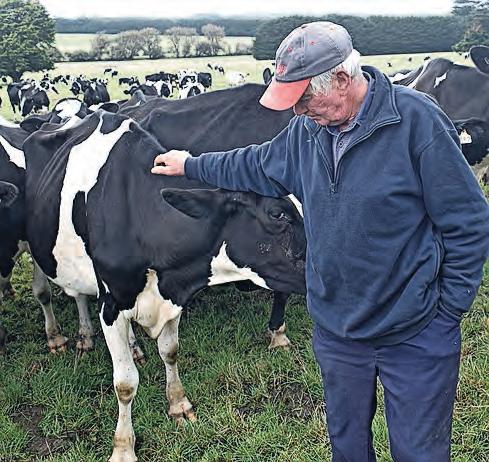
“You talk to the old blokes and they’ll swear by Jack and his discussion groups,” he said.
“He worked on the basics. He’d suggest the right bulls, tell the young blokes they didn’t need a dairy with all the bells and whistles.
“He had a lot of sayings. One I remember is ‘the money you borrow in the good times, still has to be paid back in the bad times’.”
While giving back to their community through CFA, hall committee, UDV, school council and various artificial insemination bodies, Daryl and Val have also provided a training ground for many young people.
“I don’t know how many kids we’ve trained and helped to get through uni or buy a car,” Val said.
Today they don’t have any permanent staff, just milkers to help in the evening and relief so they can take an annual holiday.
“We’re still hands-on; I don’t milk but I do everything else,” Daryl said. Val milks mornings, though she admits it’s getting harder.
The main thing that keeps them interested is the love of the land — especially their view towards Mount Noorat — and the animals.
“The cows are like our kids; they’re family,” Val said.
“One staff member from New Zealand said it was the first herd she’d ever walked through without fear of being kicked. She said they’re just a marvellous lot of cows to milk.
“We don’t know the difference because we’ve never milked anyone else’s cows.”
Jack Green used to say the farmer dictates the temperament of the animals and Daryl and Val have always bred for a calm temperament and good udders.
“We wanted cows you could get along with,” Daryl said.
“You just have to call them and they come; they trust us,” Val added.
They remain ‘old school’ when it comes to
calving which is once a year, starting in June, with cows drying off from April 23.
They are all AI-bred, the system they’ve used since 1969, and they are keen progeny testers. Photos of their herd have been used many times over the years on promotional brochures.
There are as many photos of cows on the walls as people. Pride of place goes to the progeny of Medallion from the Horizon Progeny Test Program that found fame around the world.

Their cows produce between 32 and 35 litres at their peak, the farm rarely misses an annual milk quality award and they also have two Genetics Australia Golden Cow awards.

Not much rankles Daryl, but animal liberationists complaining about dairy farmers get him fired up.
“One of the most annoying things is the animal libbers who claim dairy farmers are cruel,” he said.
“They should go out on a farm and come around with us at 10 o’clock at night when they’re calving and we want to make sure everything is all right.
“We treat our animals better than we treat ourselves. If you walk out in the paddock and they see you as a friend and walk up and want to lick you, where’s the cruelty?”
With a focus on keeping things simple, Daryl says cows haven’t changed; farmers have, and along the way they’ve bred a better cow.
“When we first started, I was secretary of the Ecklin Herd Test Association,” Daryl said.
“A top herd in those days averaged 13.5 litres at their peak; if they did that these days, they’d be out the door.
“Genetics has been the difference and now we’ve got better cows. They used to have
hairy udders or udders that almost dragged on the ground.”
Advances in health and feed have also helped to develop more profitable cows.
“When I was a kid, if a cow had milk fever there was no such thing as a calcium injection. Bloat used to be a problem if you had too much clover in a paddock, but now we’ve got additives to put in the feed for everything.”
While they love Dixie, the area has been threatened by fire several times.
Daryl has been a CFA volunteer for more than 60 years and remains active as a first lieutenant.
He recalls close calls while battling the Ash Wednesday fires of 1983 and St Patrick’s Day fires of 2018.
For many years, the Dixie fire truck was housed at their farm. On bad fire nights the property on a hill with an expansive view becomes a beacon for other local residents.
“Back when I started, things were simple,” Daryl said.
“Everyone was in the fire brigade. Farmers had to band together to protect their properties. Today with a lot of corporate farms, you’ve lost that sense of community.”
Although they have no plans to sell at this stage, Daryl admits “the hills are getting steeper”.
“I try to discuss retirement but he won’t listen,” Val said.
Their son is a politician in Queensland and has no interest in the farm but their daughter and her husband are keen to take over the family farm when Daryl is ready to take a step back.
“We’ve got to live in Dixie. Dixie has been our life,” Val said.
“People say why don’t you shift to Warrnambool. Why would I want to go to Warrnambool? All my friends are here.”
Although they have no plans to sell at this stage, Daryl admits “the hills are getting steeper”. The farm has received a milk quality award virtually every year and the Crawfords have won two Golden Cow awards. Daryl and Val say their cows are part of the family, and they get upset when animal liberationists insult dairy farmers. Being part of the community is important to the Crawfords. Daryl has been a CFA volunteer for more than 60 years.FULLY HOT DIP GALVANISED DAIRY SHEDS
Designed to improve animal comfort and performance & manufactured to withstand the demands of the dairy environment.



YOUR TRUSTED FARM SHED SUPPLIER

ROBERT NEAL doesn’t know how many kilometres his 1979 canary yellow Toyota HiLux ute has done because it re-sets to zero after every 99,999.

But he does know that the few kilometres he

drove it from the Hopkins River at Framlingham on February 16, 1983 saved his life.
The car is no longer registered but still starts every time Robert fires it up for a job around his farm at Ballangeich.
Although he has more modern vehicles at his disposal, he’s going to keep this lucky charm for as long as it runs.
Robert was one of hundreds of south-west Victorian dairy farmers impacted by the Ash Wednesday bushfires.
He was one of the lucky ones. He emerged unscathed and his family farm and the property he was sharefarming at the time missed the worst of the blaze.
However, he came face-to-face with the devastating fire and only survived thanks to a few split-second decisions.
Today, Robert and his wife Sharyn live on the Ballangeich farm started by his parents. Their son Paul now runs the business in a sharefarming agreement
Robert and Sharyn married in 1980 and went sharefarming with the Jellie brothers near the East Framlingham Golf Course.
They were there when the fire started, about 5km from their current farm on the Hopkins Highway.
Robert saw the smoke and got on his motorbike and rode over to see what was going on. A local CFA volunteer, he jumped on a private truck with a pump on it.
“We tried to catch it,” he said.
“We were fighting on the right-hand side and it went past us on the left-hand side. It was gone. You couldn’t achieve anything with one truck.”
Robert has many clear recollections of the day.
“I remember little whirly-winds of fire. I think it was cow manure getting picked up
and tossed hundreds of metres down the paddock. As soon as it hit, the ground was on fire and everything was burning.
“It kept doing that — kept getting ahead of itself.”
The private tanker ran out of water so Robert got back on his bike and returned to the sharefarm to put the cows in the dairy.
“I thought if it came our way, the cows had no hope out in the paddock,” he said.
Sharyn, who was seven months pregnant, took their son Matthew, 2, and went to her parents at Mortlake, packing the cat, Robert’s Beatles records and video recorder.
“We’d only bought the VHS recorder and it was probably the most expensive thing we had in the house,” Robert said.
The fire went across the corner of the family farm and while it hadn’t spread too wide, the local volunteers could see it was getting away. Robert decided to go to the Hopkins River to help with a quick-fill pump near the East Framlingham bridge.
In a life-saving decision, he took the ute and left his bike at home.
“There were milk tankers coming down to the river taking off water for trucks and there were fire trucks coming left, right and centre to get water.
“I can still see the flames across the top of the bank and then the wind changed and it went silent for a little while and then all of a sudden there was an almighty roar.
“There were six or eight of us down by the river and we knew we were in strife because of the change of wind.”
Some of the volunteers jumped into the river, but Robert couldn’t swim. Instead, he followed a milk tanker driver who ran for his truck.
“I ran for my ute. By the time I got to it, the grass was on fire all around it,” he said.
“I can remember shutting the door and thinking I need to get out of here quickly. I
unharmed, except for sore eyes.
“It went straight across the top of the river; there were parts around where the pump was sitting that didn’t even get burnt,” Robert said.
The fire stopped about 150 metres from the boundary of the sharefarm.
Robert spent the next few days pumping water.
“We were putting out spot fires for the next fortnight.
“I can remember standing over the East
“I never considered getting off the land, but it made me wary about having holidays around February-March. I wasn’t game to leave the property,” Robert says.
to understand the full scope of the fire.
“I never saw a paper for the week and didn’t realise the scale of it.
“When you’re fighting fires there are a lot of rumours. Sharyn’s parents were hosting an exchange student from Finland. Her parents called because they’d heard that from Melbourne to Adelaide was on fire. “
Robert said there was no stopping the inferno.
“It wouldn’t have mattered if we had a thou-
“I was lucky I took the ute — I don’t know whether I would have been calm enough to kick-start a motorbike with flames all around me,” Robert recalls.
They shifted as planned to Scotts Creek a few months after the fire before returning to Ballangeich in 1992, initially as sharefarmers but later purchasing the property with help from Robert’s parents.


The farm has since expanded to more than 324ha and they milk about 375 Jersey cows.

“We cut all our own silage and hay and don’t buy much stuff, just some grain so we’re pretty self-sufficient,” Robert said.
Paul took over management in April when
Having a game plan is vital for success – on the field and on the farm. And creating one has never been easier. Our Farm, Our Plan, developed for dairy farmers, helps you put your goals down on paper, prepare for the season ahead (and beyond) and get your whole team on the same page.

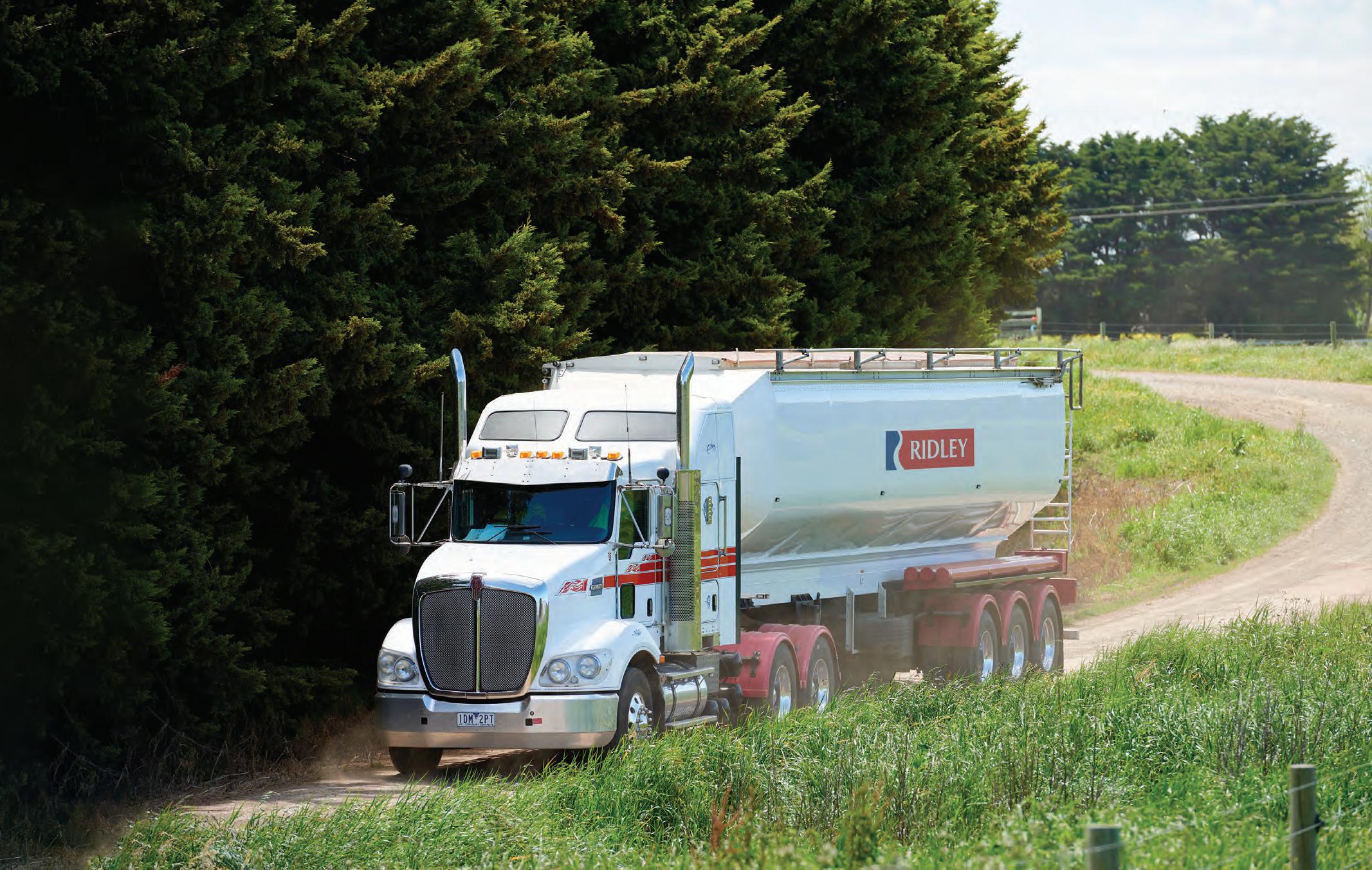





regional ‘feed centres’ which prepare complete diets and deliver direct to farms and dispense to cows on a daily basis. Most farms in a region typically receive the same prepared diet.

Some feed centres offer not just bulk deliveries, but also plastic-wrapped 25kg and up to 600kg packs which are delivered to farms and can supply feed sufficient for a several-day period.


Typical of these ‘hot’ country dairies, cows are typically housed in covered sheds and bedded on dried manure.









Milk production is under a quota system and production is largely seasonal, with lower production in the hotter summer period to help avoid peak milk production and fertility challenges in the hot conditions.

Milk processors offer a bonus for milk produced in the summer to encourage supply which many farmers have now targeted



for higher returns, though in some cases the switch is leading to a reduced bonus incentive as supply increases through this period.







The dairy industry is largely controlled by the Israeli Government, which also sets the milk price.


The Israeli dairy system is another example of how an efficient dairy production system has developed in the face of natural challenges to supply nutritious food for the local population.
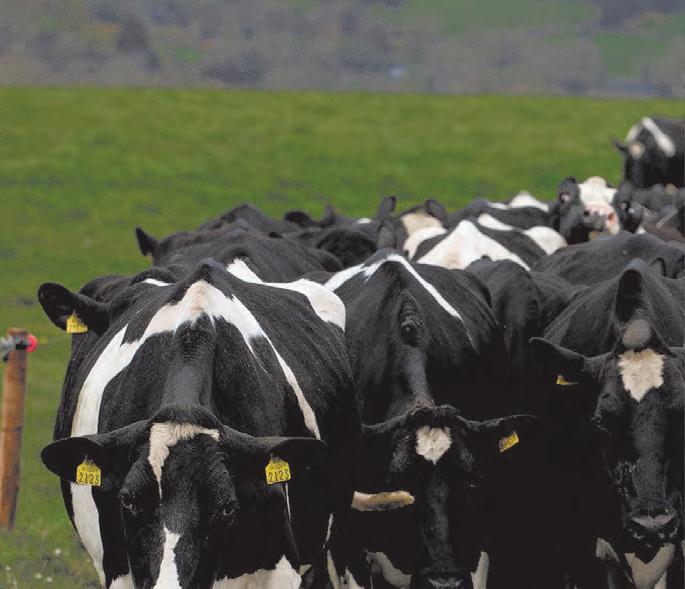
With advanced technology and nutritional experience, the Israeli dairy sector is one others can learn lessons from.





Dr Richard Kirkland is a ruminant nutritionist and global technical manager for Volac Wilmar Feed Ingredients based in the United Kingdom. His work regularly takes him to dairy farms across the globe to help identify nutritional solutions to overcome their unique challenges.




A SOUTH Gippsland dairy farmer finishes his hay making season each year with an entry into the Foster Agricultural Show.


Peter Young has favoured well known cartoon characters including Thomas the Tank Engine and Bluey and her family.
He stages his hay bale art in a paddock

alongside a school bus stop and pullover area, and attracts a lot of interest from passers-by.
Peter recently won the Foster Agricultural Show’s Bale Art Competition with this year’s installation — Bluey and her family.



It is the fourth year in a row Peter has won the Bale Art Competition.
Max Pawson, the son of one of Peter’s workers, was keen to help him celebrate his win.
In 2022, Peter Young entered Thomas the Tank Engine in the Foster Agricultural Show’s Bale Art Competition, to much acclaim. Photo: Jeanette Severs Max Pawson proudly holds the winning ribbon. Photo: Peter Young Peter Young’s entry of cartoon character Bluey and her family won the 2023 Foster show hay bale competition. Pictured on the winning bales is Max Pawson.BASE AR37 tetraploid perennial rye-grass from DLF Seeds has again come out on top of Dairy Australia’s latest Australian Forage Value Index 2023 update.
The FVI rating system helps dairy farmers make better-informed decisions when choosing a perennial rye-grass cultivar.

It provides an accurate, reliable and independent assessment of the potential economic benefit of perennial rye-grass cultivars in different dairy regions of south-east Australia.
The FVI is calculated by multiplying a cultivar’s dry matter performance value by its economic value, and Base AR37 perennial rye-grass topped the rankings across all four areas tested in south-west Victoria, Gippsland, northern Victoria and Tasmania for 2023.
“This result, coupled with the fact that it’s Australian-bred, really demonstrates its value to Australian farmers,” DLF Seeds national sales marketing manager Jason Agars said.

“The performance of Base AR37 in our conditions is exceptional and its fit across farming systems in southern Australia continues to expand.

“In the current environment, with strong milk and red meat markets, it makes a lot of sense to choose the variety that will drive the most productivity.”
AR37 endophyte provides Base AR37 with the best balance of pasture production and persistence, insect control, higher tiller density over time and increased total dry matter production compared to rye-grass cultivars containing AR1 or nil endophyte.
“AR37 really takes rye-grass pasture persistence to a premium level providing protection against Argentine stem weevil, pasture mealy bug, African black beetle and root aphid,” DLF Seeds product development manager Isaac Berry said.
“Autumn recovery is a true standout for Base AR37, and this can be attributed to AR37 providing protection during critical times allowing Base to maintain a high tiller density and recover faster when the autumn break occurs.”

Base AR37 is Australian-bred for Australian conditions and has been the number one performer in the FVI for six consecutive years from 2018 through to 2023.

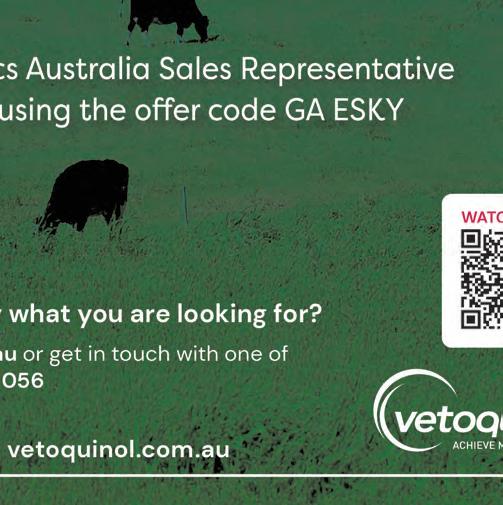

DLF Seeds said the superb dry matter yield Base AR37 offers, coupled with premium insect control, means more feed is available for stock and persistence is optimised.
Additional information on the Australian Forage Value Index and the 2023 Forage Value Index Pasture Tables can be found on the Dairy Australia website.


Our

THE QUEENSLAND Farmers’ Federation has welcomed the Queensland Government’s decision to endorse more equitable and consistent irrigation pricing arrangements for farmers through state-owned water supply schemes.
Queensland Regional Development and Water Minister Glenn Butcher confirmed that irrigation prices in all Sunwater and Seqwater supply schemes would soon be capped at the Queensland Competition Authority’s assessed cost reflective level, often referred to as the lower bound price.





Through the policy change, where water prices are higher than lower bound prudent and efficient costs, prices will now be reduced to reflect the efficient or actual cost, whichever is lower.
Current water prices that are below cost reflective prices, will continue to transition towards cost reflective prices as per the irrigation price path.
“QFF and its industry members have been advocating for many years on water pricing structures and the inequities this pricing can present for Queensland farmers,” QFF CEO Jo Sheppard said.
“Queensland’s agricultural sector has some of the highest input costs in the world and this decision will not only benefit farmers, but there will also be ongoing and broader economic benefits borne from the increased use of water due to affordability,” she said.
“This will include more jobs, more profitability for farming businesses resulting in more expenditure in regional communities, as well as ensuring fresh food is affordable for all Queenslanders.
“QFF welcomed the opportunity to work with the government’s to support this recommendation which will benefit our members and irrigators across Queensland more broadly.”
Mr Butcher said his government’s decision provided for more equitable and consistent irrigation pricing arrangements across all schemes.
“Agriculture is one of the major contributors to Queensland’s economy so it’s absolutely critical that we do whatever we can, to make sure product is making it from paddock to sale in the most efficient way possible,” he said.




“We know this decision will help contribute to more good jobs and the continuation of great services provided by Queensland farmers, which is a priority for the Palaszczuk Government.”
The QCA will now review irrigation water pricing through consultation with irrigators, with the current price path to remain until to 2024-25.
A cap on irrigation prices in all Sunwater and Seqwater supply schemes has been welcomed by Queensland irrigators.Queensland’s agricultural sector has some of the highest input costs in the world and this decision will not only bene t farmers, but there will also be ongoing and broader economic bene ts borne from the increased use of water due to a ordability.
“HELPING FARMERS achieve the best possible results with the resources they have available.”
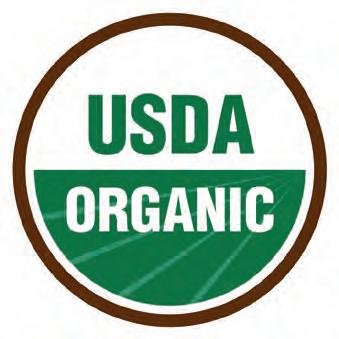

This is the outcome that MaxCare is trying to achieve with their clients, according to business manager Tom Newton.
“There is so much information, so many opinions and so many different systems, it can be challenging,” he said.
“One of our roles is to simplify that information and put it into a form that is easier for the farmer to digest and that is most relevant for their operation.”
Tom said this had led to the release of two new tools from MaxCare ready for autumn calf rearing in 2023.
“We have worked on the best platform to provide information — there are some great resources already in the market, so we wanted to deliver something that simplifies the messaging around calf rearing and complements the existing information.”

The MaxCare App and Rearing ‘Cheat Sheet’ are designed to make farmers’ lives easier.
The key functions include:


ɋ Calculators: To assist with cost comparisons, product and calf requirements.

ɋ How tos: A range of protocols to assist with on-farm systems and processes. These cover a number of topics under nutrition, comfort and hygiene.

ɋ P roducts: A snapshot of the MaxCare product range.
ɋ Request a quote: A simple way to link into MaxCare and the rural store network to get information about products.

The ‘Cheat Sheet’ is a summary to assist with management leading into and during the season.
“We have tried to highlight the key areas that need focus through the whole calf rearing cycle to give farmers an easy reference point to check in,” Tom said.
Pre-calving care, colostrum, nutrition, weaning and health management are the key areas that MaxCare has highlighted and can provide detailed protocols around the processes required at each step.
MaxCare specialises in infant animal nu trition and provides a range of milk replacers, electrolytes, probiotics and whole milk additives that suit all calf rearing systems.
ɋ For more information, visit:https:// maxumanimal.com/
Save yourself from hoof hassles
Strong, Easy, and Safe. Proven on thousands of farms since 1995.
Braked winches, easy access
All cow handling tasks Essential for every Cowshed.
“Make it quick, easy, & safe & staff will happily do hooves.”
Stock available for direct delivery
MaxCare app calculators.We have tried to highlight the key areas that need focus through the whole calf rearing cycle to give farmers an easy reference point to check in.
A COUPLE of Victorian farmers are pushing against the boundaries of conventional dairy farming, taking risks to prove their long-term sustainability.
Wilandra Farms’ owners, Sandra Jefford and Wilco Droppert, milk about 350 cows yearround off 380 hectares of sandy loam over clay soils, on flat to slightly undulating country at Clydebank in East Gippsland.

About 180ha of the farm can be irrigated. Two-thirds of the irrigation water is from bores, the remainder is from a pumping licence on the Avon River.
“We’re very reliant on irrigation,” Sandra said.
“The district’s long term average annual rainfall is about 600mm, but this is becoming more variable and unreliable.”
The herd is predominantly British Friesian and is split-calving. Cows calve from February to May, and August to mid-November.
The herd grazes multi-species pastures, including plantain and chicory, and the grain ration is 450kg/cow/year to encourage the milkers to rely on pasture for production and health.
Soil and pasture tests are used to identify plant and soil health, the level of trace elements, and what the soil microbes need for optimum performance and transferring nutrients to plants.
“We don’t yet have the Brix levels where we want them,” Sandra said.
“Some of the multi-species crops grow well, especially where we irrigate.”
Pasture is grazed to ensure groundcover and minimise the soil’s exposure to sun, wind and heavy rain; and Wilandra Farms’ herd grazes at a lower stocking rate than would normally be recommended in conventional farming.
Since moving to the Clydebank farm in 2011, and as part of their environmental focus, Sandra and Wilco have set aside three areas of their farm — altogether about 28ha — using fencing to exclude cattle and encourage natural regeneration and biodiversity restoration.
One area is a natural lagoon, one is grassland with mature red gum trees, and another is a natural saline wetland.
“They’re areas where we’re allowing nature to flourish,” Sandra said.
The couple has identified at least 90 species of birds that either visit or have made the farm their home.
Along the renewable energy journey, the

For the past 10 years we have made major advances in our entire lactation nutrition program by incorporating AMS Dairy Lick into the far-off dry cow period. Essentially a combination of macro and micro minerals balanced to build a stronger ‘bone bank’ in the cow’s skeleton, which is fully replenished over the dry period rather than being mined away.
THE BENEFITS ARE:
• Loading up a fully mineralised ‘bone bank’ allows the springing cow to call on minerals during transition and into early lactation.
• When fed as a precursor to AMS Get Set Cow leed feed, we see reduced sub clinical milk fever symptoms such as leaking teats, mastitis, and greatly reduced withheld placental cleanings.
• Calves are born stronger, healthier, and of great colour, due to mother building minerals into the growing foetus in utero. Born calves then drink higher immunoglobulin concentration in colostrum.
• Enhanced breeding rates from building healthier eggs long before they are needed, due to feeding the year-long mineral program.
• Less lameness through Zinc supplementation over the dry period which continues to keep hooves hardened throughout growth, so you don’t experience a period of so hooves eight weeks into lactation.
For more information about how AMS Dairy Lick and the enhanced mineral program of AMS Go Cow Dairy Mineral Supplements, can improve your herds nutrition contact:


Animal Mineral Solutions /Dairy Business Centre
Call: 03 5831 2176
Vist: www.animalmineralsolutions.com.au
email: hjm@dairybusinesscentre.com.au

couple has also realised the dams are a natural battery.
After embracing organic and regenerative practices within their farming system, Wilandra Farms sought and achieved organic accreditation for their milk. Accreditation is supported by an annual on-site audit.
Regenerating the soil is part of the couple’s plans to encourage more plant diversity and healthier soil, after decades of intensive production on the farm.
They’ve improved pasture cover and water retention in the soil and increased the soil carbon — with a focus on sequestering carbon on the farm.
They also have a project to plant 100,000 trees by 2030.
In 2017, deep in drought, Wilco and Sandra were horrified at how much money they spent irrigating.
“It was a very dry year,” Sandra said.
“We used 500,000 kilowatt hours of electricity and 23,000 litres of diesel to irrigate pasture.

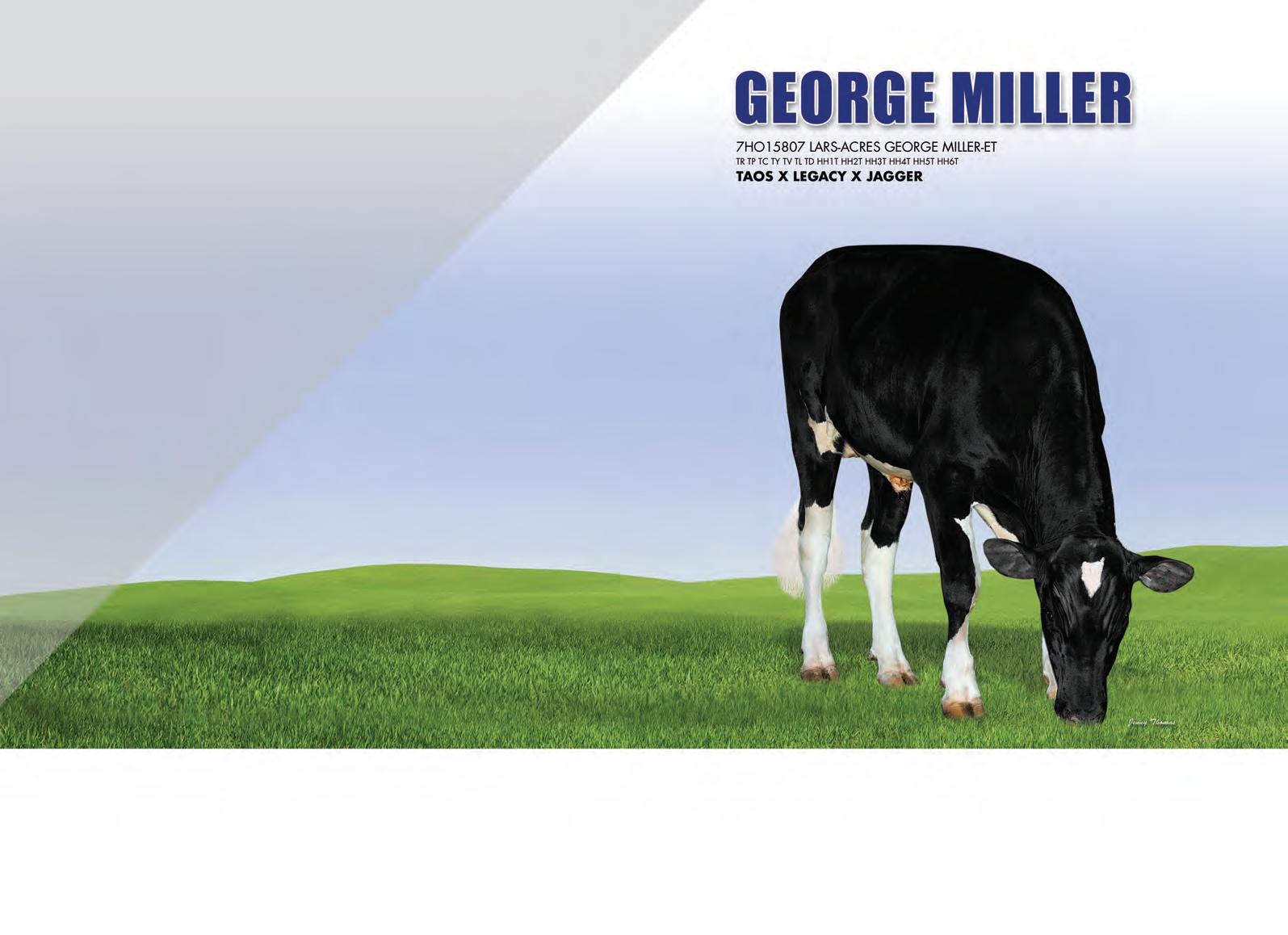
“Our energy costs were too much for a farm our size and production.
“We were responsible for massive greenhouse gas emissions, with huge energy bills — and we wanted to change both.”
So they decided to change their business model.
In 2018, they employed Rob Welke, of Water Pumping Institute, to undertake an energy audit.
“His report gave us an enormous amount of information, with recommendations for making our irrigation system more efficient, and how
we could generate our own power, how we could reduce our carbon footprint, and how we can prepare the farm for the future,” Sandra said.
Those recommendations included changing the diameter of the pipeline from the bore and replacing at least one pump.
“So we installed Rob’s recommended submersible pump in the dam, with a greater flow capacity and a new pipe,” Sandra said.
“Both these changes alone were estimated to give us savings of about $18,000 per year, with a payback time of two years.
“If we hadn’t had the energy audit done, we wouldn’t have known.
“We also wanted to get away from using a diesel pump at the dam, and use two electric pumps at the dam.
“Installing the second pump at the dam gives us double the pumping capacity to previously, so we can shift as much water as we can during daylight hours.”
Then Steve Soutar, of Alternate Energy Innovations, helped Wilco and Sandra to develop a renewable energy action plan that enabled Wilandra Farms to be awarded funding through the Agriculture Energy Investment Plan, administered through Agriculture Victoria.
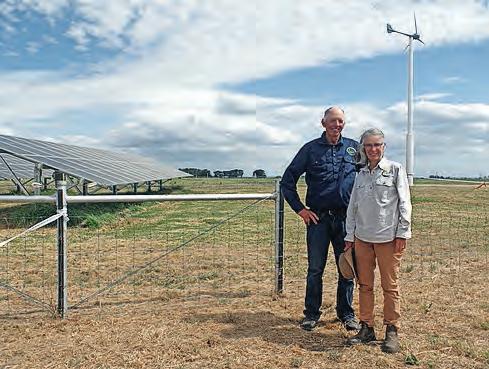
“That enabled us to upgrade some of our existing infrastructure and install solar panels and wind turbines within an integrated system,” Sandra said.
They also put a finance proposal to Rabobank, to enable them to reduce their energy and irrigation expenditure and acquire new equipment.
“Similar to many farms, our centre pivots had no automation, so someone had to be there to start the pivot, then go to the water sources to get the pumps started,” Sandra said.
“And the water sources are not next to the pivots, so there’s some distance and time involved.
“When pivots got stuck in wet spots, the water kept pumping so the wet spots got wetter.
“We also mainly irrigated at night, using off-peak power, so if a pivot stopped working during the night we didn’t know about it unless one of us woke up, saw the light had stopped, and then woke someone else up to say, ‘sorry, you’ve got to go outside’.”
It meant sleep was a luxury.
New infrastructure has included a new centre pivot, which means more country is under irrigation.
The pay-off for more irrigation is the cost of irrigating.
“So our power requirement has increased,” Sandra said.
“But in going to renewable energy, we don’t have to pay for as much grid power.


“Overall, our principal focus is to make tasks as energy efficient as possible, so we use less power.”

Back in 2017, Sandra and Wilco installed solar panels on the roof of the dairy.
But because all the panels face north, there is no shoulder power generated. And shoulder power generation is more optimal for milking times.
Gabriel Hakim was brought in to advise on energy efficiency in the dairy.
“We changed the timing for heating hot water,” Sandra said.
“We switched from using off-peak grid electricity to using power generated from the solar panels during the middle of the day, and that’s been a big advantage financially.”
A low vacuum pump replaced two old oil vacuum pumps. This has reduced power use and it’s a much cleaner operation, not requiring oil changes.
“Then we installed a CO2 heat pump to replace a conventional hot water service, which contributed about a 40 per cent reduction in energy use,” Sandra said.
Continued on page 25
Wilco Droppert and Sandra Jefford have installed four wind turbines and considerable solar panels to generate energy for irrigating, milking and other power uses on their dairy farm at Clydebank.CLASS LEADING GRAIN MILLING TECHNOLOGY



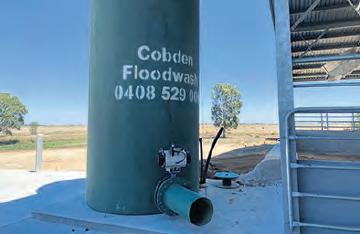

UNPARALLELED MILLING EFFICIENCY AND ENERGY CONSUMPTION



BETTER UTILISATION OF YOUR GRAIN

EUROPEAN QUALITY AND MANUFACTURED

MEMBERS OF the Australian dairy industry are set for a night of reflection and celebration when the 25-year anniversary reunion of the Don Campbell Memorial Tour is held in May.
Hosted by GippsDairy, past participants, leaders and hosts of the study tour are invited to come along and reconnect with fellow participants and hear what the initiative has achieved over a quarter of a century.

The reunion will be held at the Oaks at Logan Park in Warragul on Friday, May 5 from 5pm. Tickets are $50, and this includes a twocourse meal and beverages.
GippsDairy regional extension officer and event organiser Katherine Byrne said it would be a night to remember.
“The Don Campbell Memorial Tour gives young members of the dairy industry the opportunity to grow as individuals and expand their careers,” Katherine said.
“This is achieved through leadership and exposure to the wider dairy community and practices.

“We are looking forward to bringing past participants together and reigniting old connections, while fostering new relationships between people.
“Participants have not only been from the Gippsland region, but also from South Australia, western Victoria and northern Victoria — so we’re keen to have everyone come together and acknowledge this special occasion.”
The evening will feature guest speaker and past participant, Graeme Nicoll, who will be sharing his Don Campbell Memorial Tour experience and subsequent career.
This will be followed by entertainment supplied by Phil Bowler Caricatures.
Don Campbell was a prominent member of the Gippsland dairy community in the 1990s.

His contribution to the formation of GippsDairy was immense — Don recognised
that collaboration between regions and sharing knowledge was beneficial to all Australian dairy farmers.
He held the first chair position at GippsDairy in 1996 and was honoured for his contribution to the community with the naming of the tour after his sudden death in 1998.
During 25 years, the study tour has seen more than 300 participants who have been involved with the Young Dairy Network.
The 2023 tour was held in February, with 15 young dairy farmers in attendance having the opportunity to attend the Australian Dairy Conference.
If you have any photographic or video memories of the Don Campbell Memorial Tour or would like further information, please contact Katherine Byrne on 0409 487 275 or email katherine.byrne@gippsdairy.com.au
“We added a small circulation pump to reticulate the hot water within the system. But, in hindsight and given the cost of that unit, our preference would be to install more solar panels on the dairy roof and a new conventional hot water service.
“Solar panels can do more than one job.”
They also installed a new bore to service the new heat exchanger.
“That’s worked really well and we’re monitoring it,” Sandra said.
They’ve had to install control boxes on the pivots and onto the river and bore pumps.
“We have 150 kW of solar (panels) and 20 kW of wind turbine energy (four 5kW wind turbines) at the back of the farm near the dam,” Sandra said.
“We think the wind turbines will play an important role in providing power in the afternoon and evening.
“And if it’s windy in the morning and we’re running a microgrid, that power could possibly be used in the dairy.
“The energy management system is a critical component. The system knows what to operate and when power is available, and it can juggle the load to match the power that’s available.”
They pump out of bores and the Avon River into the dam, using it as a water bank.

“The dam plays an important role for us,” Sandra said.
“If we need water into the dam, it starts pumping from a bore as soon as we have 10 kW
of power available.
“As solar power increases during the day, this pump will speed up to more than 30 kW.
“As soon as we have 37 kW of power available at the dam, the bore pump turns off and the dam pump starts, and the centre pivot operates just like magic.”
The comparison in energy costs is considerable.
In the 2021 season, irrigation cost Wilandra Farms $80,000. In the 2022 season, it cost $1200.



“The huge decrease was due to energy efficient measures implemented, the rainfall last year, and the use of renewable energy,” Sandra said.
The reduced cost from electricity and fuel includes less driving, less wear and tear of the
quad bikes or side-by-sides, and time saving.
“It’s less wear and tear on our bodies,” Sandra said.
“We’ve saved at least 15 hours a week.
“If a pivot does get bogged, it stops and the water pump turns off straight away.
“This new system has less damage to pivots and should lower our greenhouse gas emissions.”
Wilandra Farms has recently invested in two more pivots and brought those into the automated system.

Ultimately the couple wants to create a microgrid, and their system is geared towards accommodating this, along with battery storage.
“We’re also actively managing to increase soil carbon and we’ve registered a soil carbon
project,” Sandra said.
Wilandra Farms is registered with the Victorian Government’s Farm Emissions Pilot Project, administered by Agriculture Victoria. An emissions profile in 2021-22 identified cattle, dung, nitrous oxide and carbon dioxide as major pollutants, with trees and soil health helping to balance that data.
Wilandra Farms’ principals hosted a field day on February 2 to enable farmers, agronomists and other agricultural technicians to learn more about how Sandra and Wilco have used technology to reduce irrigation energy costs by 80 per cent and labour input by about 15 hours/ week, improve water efficiency, switch irrigation from night-time to daylight hours, and impact positively on Wilandra Farms’ carbon footprint.

We design, manufacture and supply precast concrete products for agricultural and commercial uses. To view our full product range visit the shop.

MILCast have the capacity to manufacture and supply bulk products to corporate customers. Products can be from our existing catalogue or made-to-order.
MILCast not only supplies to local landholders and businesses, but also assists large scale projects afar.

The MILCast team can design made-to-order structures based on your specific needs, including pipe brand selection and control door requirements.
MILCast can design made-toorder structures based on your specific needs, including pipe brand selection and control door requirements.

NiteMoooves returns






Dairy NiteMoooves is WestVic Dairy’s feature event for 2023.









Scheduled to be held at the Noorat Recreation Reserve on the evening of Wednesday, May 24, this fun-filled evening will be an opportunity for people in the dairy industry to enjoy a great night out with fabulous food, entertainment and music.

The event will feature Tom Newton as MC and Cameron Ling as keynote speaker. Attendees will enjoy a three-course meal (a delicious grazing table on arrival, a main and a dessert).
Local band The Vulkans will entertain with some of the best tunes from the last few decades.


This evening provides a valuable opportunity for attendees to network with farmers, service providers and industry contacts, while at the same time enjoying a fantastic night out.
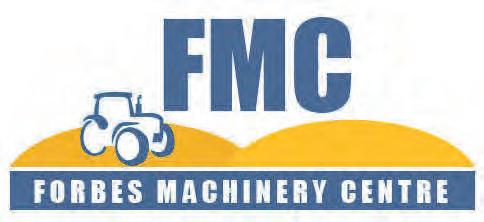
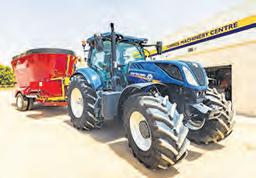
Tickets are on sale now at: Eventbrite: https://bit.ly/DairyNiteMoooves_Tickets
Award nominations open






The Great South West Dairy Awards will now be held biannually and in 2024 will again recognise the best in the industry across a range of categories.
However, the Farm Photo of the Year and Honour Board induction run annually.

Networking, top shots and honour board inductees are all part of this year’s Dairy NiteMoooves event to be held in May.



Nominations are now open and can be downloaded at: https://bit.ly/DairyNiteMoooves23. Alternatively, call the WestVic Dairy office on (03) 5557 1000 to request an application form or to nominate someone who you feel excels in the industry and deserves recognition for their efforts.
Nominations close May 1, and winners will be announced at Dairy NiteMoooves on May 24.
There are various opportunities for local businesses to support the event through different sponsorship packages.

To receive a sponsorship document, email awards@westvicdairy.com.au

THE OVER-USE of anthelmintics (drenches) for the chemical control of gastrointestinal worms has led to resistant worm populations in many areas of the world. This article discusses the use of non-chemical control, along with strategic drenching, to minimise the threat of drench resistance on your farm.
Traditionally, worm control in dairy heifers involved regular and routine anthelmintic treatments, for example every four weeks, with four to six treatments per season.
It was recommended that treatment was followed by moving to a ‘safe’ pasture, which was considered to have a low burden of worms.
While such regimes have controlled gastrointestinal worms reasonably well, they have led to the survival of a minority population of resistant worms.
These surviving resistant worms subsequently parent the next generation of worms, leading to a majority population of resistant worms, where the original anthelmintic will no longer have an effect.
Think of this as inadvertent ‘genetic selection’ for the resistant genes, similar to how we select for specific traits in cattle.
More recently, the concept of ‘refugia’ has been proposed as the most important factor to slow the development of anthelmintic resistance.
The number of worms in refugia is the number that are not exposed to the drench.
Here the term ‘worms’ refers to all stages of the worm life cycle (eggs, larvae, immature and adult worm).
There are three main ways that worms can
be in refugia (that is, not exposed to a drench): Un-drenched heifers, in a mob that have received drench.

Inhibited larvae of some worm species, when they are not susceptible to a drench.
Worms on the pasture cannot be exposed to a drench, so are always in refugia.
Worms ingested after a drench will dilute any remaining resistant worms, so these do not become a significant proportion of the total worm population in the heifer.
These susceptible worms contribute to the next generation of worms, delaying the development of resistance.
However, there is a conflict between managing drench resistance and gaining good worm control.
Maintaining too many worms in refugia to dilute drench-resistant worms also means more worms to infect heifers after drenching. There needs to be a compromise to prolong the use of effective drenches.
In practice, we need to re-think the way worm burdens are managed.
In the past, drenching programs focused on elimination of infective stages.
Instead, we need to focus on maximising the contribution made by the susceptible worms to the next generation.
There are a few strategies to help achieve this: Treat and stay: Putting anthelmintictreated heifers back on to known contaminated pasture for a short period, to expose
them to susceptible worms in refugia. Unfortunately, the long duration of action of some anthelmintics will result in susceptible worms being killed and only resistant worms surviving to produce the next generation of worms.
Move then treat: Heifers are placed onto a ‘safe’ pasture at least one week prior to drench treatment. This allows some pasture contamination by unexposed worms, to provide a small population in refugia.

Selective treatment: Of heifers that show evidence of worm infestation (diarrhoea, ill-thriftiness, poor weight gain) and leave some heifers untreated.
Avoid using: Long-acting anthelmintics or those that kill all developmental stages of worms in the animal. These anthelmintics will kill susceptible worms in refugia. Avoid treating: Adult cows that have developed immunity. These animals are largely resistant to worm infestations but will still have a worm burden to some degree. It is controversial as to whether such burdens affect productivity in early lactation.
In addition to maintaining worms in refugia, other practices to delay the development of drench resistance include: Avoid drenching more frequently than once monthly, unless there is a specific need, in consultation with your veterinarian. Quarantine all introduced stock and drench on arrival.
Use effective combination drenches. Weigh animals prior to drenching to establish an appropriate dose.
Administer the correct dose using the correct technique for the product.
A commonly used strategy for managing worm burdens is ‘monitor and treat’.

Faecal egg counts, body condition, live weight gain, pasture length and predicted larval contamination of pasture are used to decide when to treat heifers.
A faecal egg count (FEC) estimates the worm burden in an animal. They can be carried out on individual faecal samples or pooled to provide an assessment of a group of animals.
It is recommended that FECs are performed prior to treatment to determine if drenching is necessary. FECs can also be used to assess the effectiveness of a drench.
Testing for drench resistance
A ‘drench check’ is usually carried out around 10 days after a drench treatment and should yield zero eggs in the faeces of 10 randomly selected treated animals.
If the results indicate a worm burden, then further testing may be required to check for the development of resistance.
Discuss the use of FECs and drench testing with your veterinarian.
This article has been adapted from an original Apiam article published in Dairy News Australia in November 2017.



KIOTI’S HX Series of high horsepower, premium tractors has arrived in Australia, completing a full service offering from the South Korean manufacturer.

All major components are built by partner Daedong, including engine, transmission, cabin and planetary drive front axle.
The HX Series comprises two models, with respective outputs of 130 hp and 140 hp, and features the fuel-efficient CRDI 3.8-litre diesel engine, a luxurious and spacious working environment, eight-speed Powershift, 32 x 32 transmission, 230-litre fuel tank and a whopping 4852kg lift capacity.
Other features include:
adjustable multifunctional armrest; work and drive modes to change the take up point of the clutch;
three-speed PTO with PTO cruise control which sets the working rpm; automatically disengages from four-wheel drive when travelling more than 20 km/h; air seat which swivels both ways, head rest, seat warmer and comfort trainer seat; and limited slip front differential.
The tractors have a sturdy, imposing footprint ideal for rugged paddock work, cultivation, heavy duty lifting, hay making, road travel and all manner of towing implements.
PFG Australia, who have distributed Daedong/ Kioti since 2000, recently unveiled the HX to its dealer network ahead of a wider national launch.
Michael Cook, dealer co-principal at Engage Ag in Toowoomba, Queensland, said the
tractor took “Kioti into the serious farming segment and it’s the next step for Kioti in terms of refinement”.
“By that I mean style, finish, cab and weight,” he said.
“Plus, we know this will build on their reputation — the R&D and quality is there.”
Kioti Australia national sales manager Stuart Phillips said while they had anticipated a surge in interest given build up and investment in the
HX, the Australian response to the release was “phenomenal”.
“The way it looks, its capabilities, toughness and deluxe features have set the bar to new levels,” he said.
IF YOU ARE A LARGE HERD OWNER AND DO MULTIPAL TRIPS FEEDING YOUR HERDS, THEN THE McINTOSH MULTI 4 OR MULTI 5 BALE FEEDER IS THE MACHINE FOR YOU.


These award winning bale feeders have been carefully designed to handle all types of Round bale silage and hay, without fuss. With its bale capacity, clever design and rugged construction, that makes the Multi bale feeder simple and easy to operate.

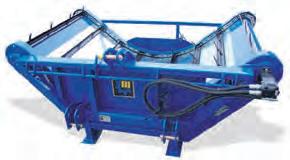

THE DAIRY industry had shown enthusiasm and commitment to a new safety initiative, launched after dairy tankers were found to be 2.4 times more likely to be involved in a major crash than other freight transport, transport and logistics specialist insurer NTI said.
Key stakeholders across the dairy supply chain, including consigners, carriers and processors, have joined the initiative Spilt Milk: A National Crash Reduction Program for the Dairy Industry, which is funded through the National Heavy Vehicle Regulator’s Heavy Vehicle Safety Initiative supported by the Federal Government, and led by NTI.
NTI chief sustainability officer Chris Hogarty said four of the largest dairy carriers and three of the largest processors had signed on.
“While the dairy industry has a history of excellent, but isolated, initiatives to improve the safety performance of milk tankers, the aim of the ‘Spilt Milk’ project is to bring together key stakeholders, expertise and initiatives, to deliver whole-of-industry solutions to this whole-of-industry issue,” Mr Hogarty said.
“The goal is to reduce dairy tanker rollovers and improve road safety by working with drivers, fleet managers and consigners,” he said, noting a similar education program in Victoria’s forestry industry resulted in a 65 per cent reduction in rollovers, from 29 in a year to 2020 being rollover free.
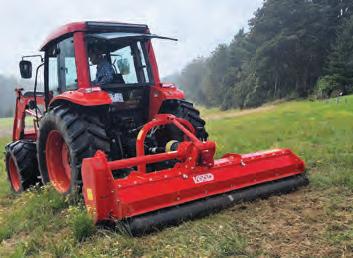
Dairy tankers have unique engineering and physical attributes as well as a unique operating
environment that make them particularly susceptible to rollovers — which make it difficult for even experienced drivers to predict.
“This is about protecting drivers and protecting the environment because dairy tanker crashes not only put those behind the wheel and road users at risk but can cause milk and diesel spills,” Mr Hogarty said.
“We need to improve education and training
resources to better share knowledge about the best and safest ways for the dairy transport industry to operate.
“In the past, traditional rollover training has been difficult to access or too expensive and we know reaching drivers is critical to effectively address this safety issue.






“Keeping Australian industry moving toward a safer and more sustainable future is our

priority and this program is another example of NTI working with industry to achieve that.”




NHVR chief executive officer Sal Petroccitto said the project had benefits for the entire dairy transport supply chain.
“Milk, like all harvest goods, must be secured to meet the loading performance standards and for the safety of the heavy vehicle industry and all road users,” Mr Petroccitto said.


O’CONNORS TOOK home the title of Dealer of the Year for three branches or more at the annual Case IH awards.
STAG Machinery from south-east Queensland claimed the award for one or two branches.









The Dealer of the Year results are based on a number of different criteria, including finance and business management, performance in sales and marketing, and parts and servicing, Advanced Farming Systems Certification and total market share.
Case IH ANZ general manager Aaron Bett congratulated the winners, highlighting their exceptional efforts over the past year and continuing commitment to the brand and their customers.
“O’Connors has again demonstrated the standard of service and performance that has
made them one of our top dealers for some time now,” Mr Bett said.
“I commend the effort, expertise and commitment so prevalent within the entire O’Connors team and across their whole network.
“For STAG Machinery Group, winning one of the brand’s top awards is great recognition for all the hard work that’s gone into establishing the group’s footprint in south-east Queensland in recent years and I look forward to seeing their ongoing growth and development.
“These dealers, and indeed all the dealers that have claimed awards this year, embody the strengths of our brand and represent the level of knowledge, service and support our customers have come to rely on.”
O’Connors CEO Gareth Webb said it was a

privilege to accept the award on behalf of his entire team.
“This award recognises each and every one of our 390 team members and the work they do every day to deliver to the highest standard for our customers,” Mr Webb said.
“Our dealership staff come together as a united team and that is what makes me particularly proud.
“We also want to thank the Case IH team and our customers for their ongoing support. We believe this is shared success and are thrilled to receive this award.”
STAG Machinery dealer principal Noel Baines, together with Craig Brimblecombe, said they were extremely proud to be recognised as a leading team.
“We believe our success is defined by our
partnership with Case IH, and our valued customers,” Mr Baines said.

“The people behind the machines are what the industry is all about. Our team is dynamic and want to do their best and be the best they can be.
“This award is a direct result of the huge effort and commitment of each member of the STAG Machinery team and we are delighted to receive this honour.”
Other award winners include: Larwoods Ag (Yorke Peninsula, South Australia) was Dealer of the Year — Parts; Larwoods Ag was Dealer of the Year — CNH Industrial Capital (one or two branches); Kenway & Clark (Moree, Goondiwindi, Inverell and Wee Waa) was crowned Dealer of the Year — CNH Industrial Capital (three branches or more).












